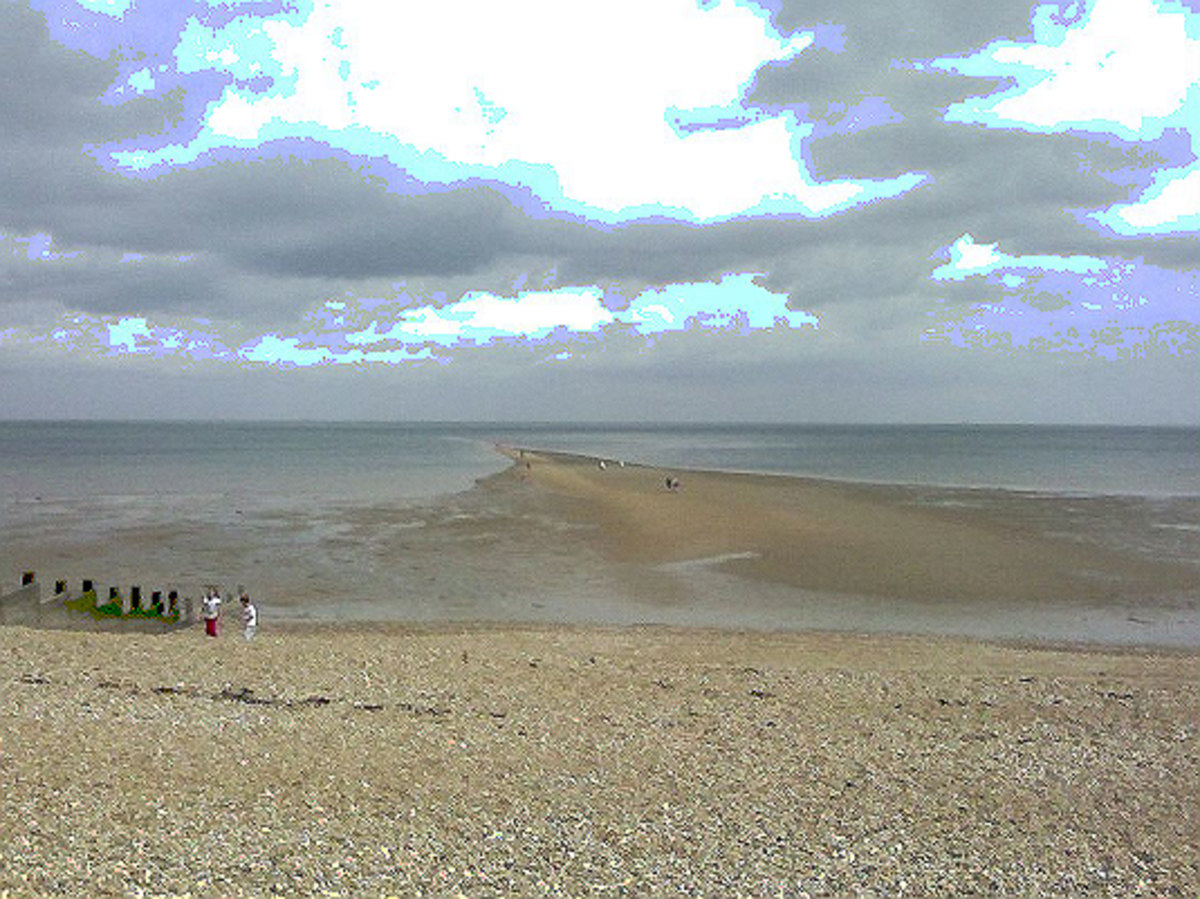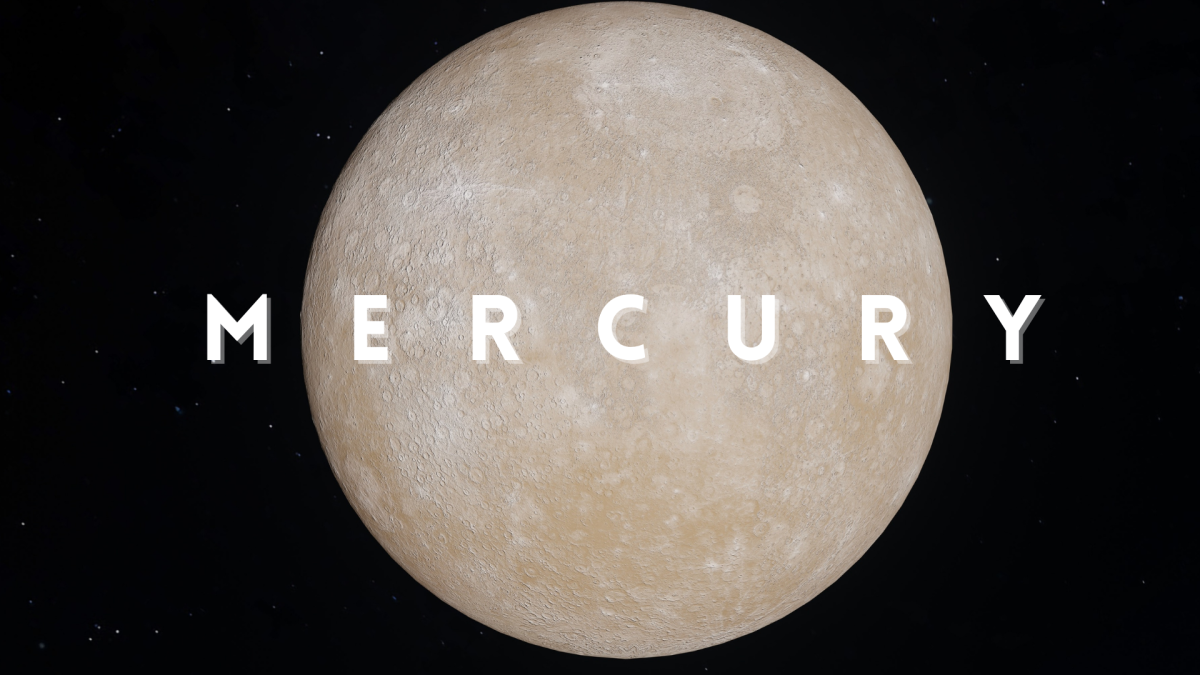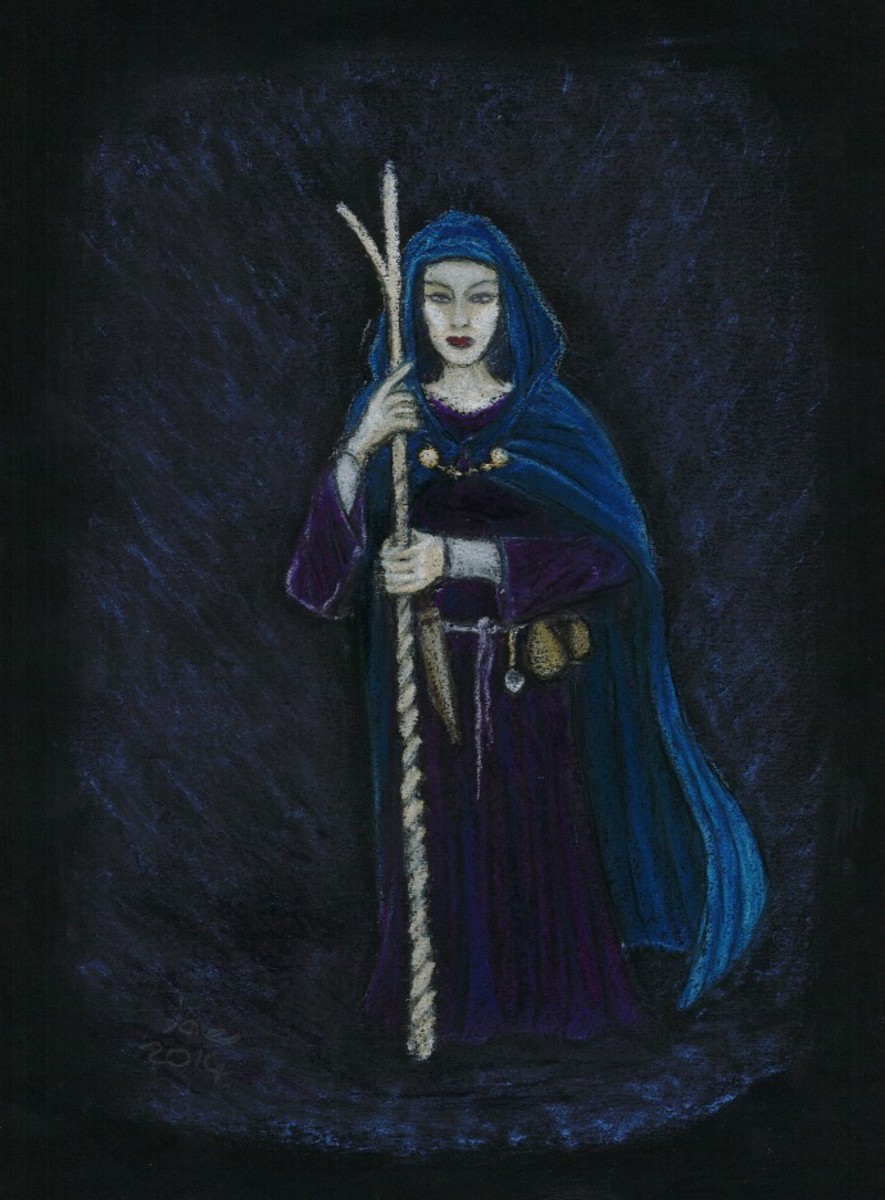The Landscape Zodiac of Britain part 11 Gemini & Summer-Solstice
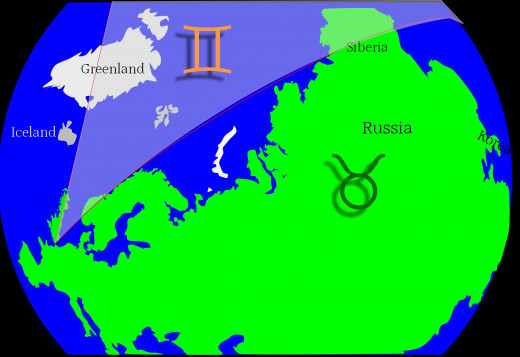
Gemini: The Intellect
Ruling planets: Mercury and Venus
Totem: The Twins or the Brothers; Duality;
Orientation: North, north east
Body: Arms and hands; frontal-lobes of brain; the nervous system
Time of day: 10am - noon
Time of year: late spring, Whitsun (Pentecost)
Third House: The mental powers; reason; written and spoken word; the local environment; brothers and sisters; relatives etc
Element: mutable air
Metal: mercury (quicksilver)
Tarot Arcana: 6, The Lovers or Brothers
The previous sign, Taurus, represented the desiring, human, earthly side of life in the flesh, while this sign introduces the heavenly portion - the pure, Geminian intellect. Mercury and the third house in a birth chart - and in a nation's - controls, among other things, the early education, development of mentality and exploration of the local environment. This is the era of the student and the youth compared with the previous chapter where we met with his/her master or teacher, the Hierophant. In spiritual evolutionary terms this was the stage at which mankind was beginning to explore his immediate environment and his real education began.
Down the ages many of the revealers of new truths, or Divine Messengers, have been born in this sign, those able to comprehend the "two great-lines of force" or the “great extremes” and rightly relate them to each other.
Inspired writers, poets, and painters usually have some strong Gemini components in their make-up.
As the sign of the early education Gemini rules that period in individual and collective life where the local environment is being explored and corresponding guidelines of proper social behaviour are being learned. Whilst the vast majority of humanity passed through this stage of exploration long ago, Gemini's all important controls are still operative, even in the most advanced societies. Education is still necessary. Thus, when mankind began his exploration of his local space environment, the craft in which the astronauts flew their first solo missions were named after the most astrologically appropriate sign: the Mercury Spacecraft was the first American manned spacecraft. The Gemini project was born late in 1961, while the first Mercury flights were underway. Gemini 3 accomplished the first orbit change by a manned spacecraft, Gemini 8 carried out the first ever space docking, and broke various other endurance records for spaceflight and extravehicular activity.
The Lovers or Brothers
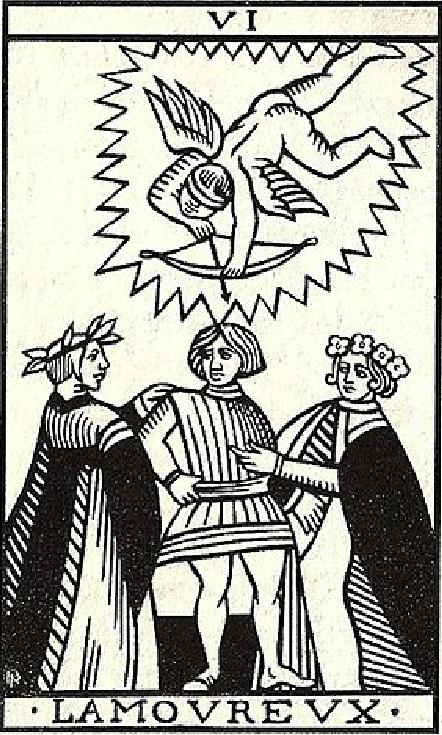
Mercury is known as 'the messenger of the gods,' and according to Alice Bailey in Esoteric Astrology - it carries messages between the poles with speed and light, heaven to earth, north to south, from the heavenly brother to the earthly brother. In Human terms Mercury is related to the etheric-body, which is the agent of communication between the higher and the lower - mind and body - spirit and soul.
In esoteric speak, the 'light of the spirit' or the higher faculties of humanity, anciently descended onto the foremost members of the human race in the symbolic form of either a bolt of lightning or some creature such as a bird. It was then up to the enlightened one to spread the light to the rest of us.
In Christianity, this is celebrated in the sign of the heavenly twins, Gemini, at Whitsun, otherwise known as Pentecost, which - they say - marks the “descent of the Holy-Spirit' upon the apostles and women followers of Jesus, seven weeks (50 days) after easter. It was the descent of the holy-spirit (in the form of a bird) which made flesh-born mankind semi-divine and quite definitely prone to bouts of schizophrenia.
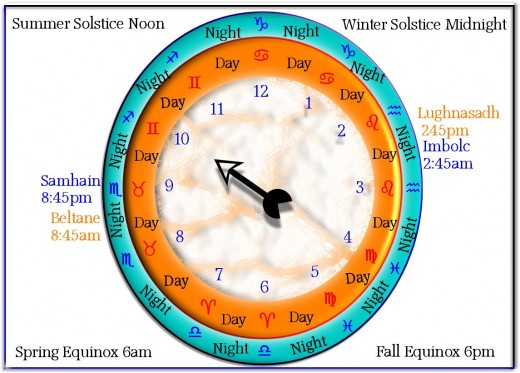
People born in this sign or who have it prominent in their chart are able to find a point of contact or some commonality with people from virtually every walk of life. This is also the reason for its trickiness, its potential to cheat or deceive those less well endowed with Mercury's wings. The archetype that best expresses Gemini’s mental abilities are 'tricksters' - divine thieves, knaves and jokers.
Every sign of the zodiac is twinned with and works hand-in-hand with its opposite sign, Aries with Libra, Taurus with Scorpio, etc; and it is Gemini that controls this twinning. As Gemini is the sign placed at the geographic north pole, its influence pervades the entire zodiac and every facet of existence on planet Earth. This is the real reason that we live in a world of extremes - the world of duality.
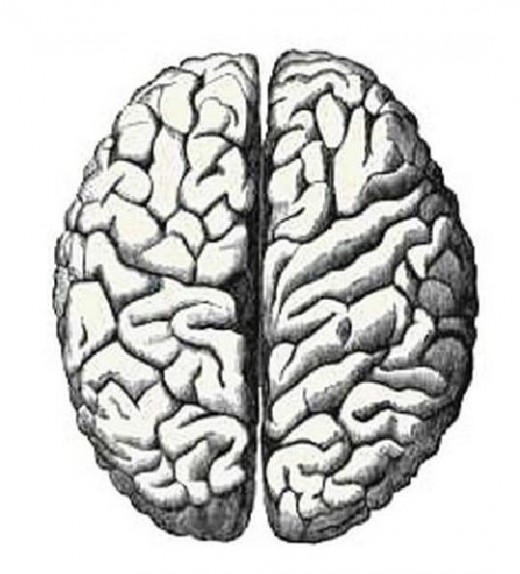
Mercury
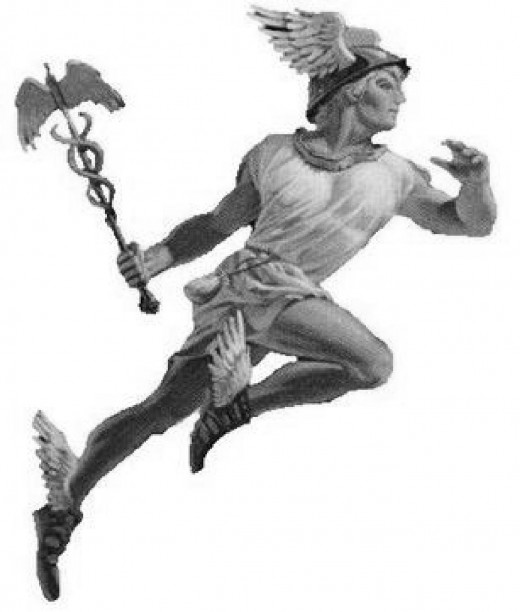
As the planet and sign of the mental powers, Gemini is physically located within the human head, which naturally relates this sign and its airy faculties with the previous two signs, also located within the head. It governs the fluids which flow within the nervous system and brain. Gemini manifests physically as the left and right hemispheres of the brain, left and right eye, twin nostrils and the two jaws. The twinning of the human legs, hands, arms and lungs is also due to Gemini's all pervasive, subtle influence.
The planet ruling Gemini - Mercury - was anthropomorphed into Hermes by the ancient Greeks. He was one of the Olympian gods, the son of Zeus and the Pleiade, Maia.
His symbols are many - the rooster and tortoise, a purse or pouch, winged sandals, winged cap, and the herald's staff or caduceus held in hand.
Hermes/Mercury was the herald or messenger of the gods to humans, sharing this role with Iris (Venus, the co-ruler of Gemini). A god of boundaries and the travellers who cross them, he was the protector of shepherds and cowherds, thieves, orators and wit, literature and poets, athletics and sports, weights and measures, invention, and commerce in general.
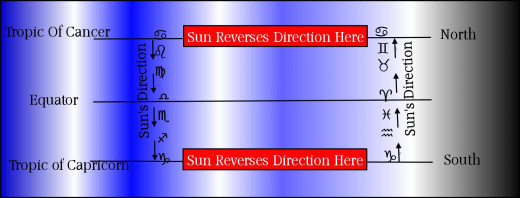
And Gemini corresponds - on the clock - to the time we modern's would call mid-morning, 10am to noon on the clock, late-spring to mid-summer on the calendar. Everyone's wide-awake and going about their daily-business, scooting-about the neighbourhood, chatting, making-lists and ticking off the items, all logical-like - like fleet-footed Hermes/Mercury.
The rising and setting Sun, passing through Mutable-Gemini at this time of year, is coming to the end of his northward journey along the horizon where he rises, will soon come to a standstill at this invisible-spot in the sky we call the Tropic of Cancer, hang-about there for three mornings, never going farther than this. and then reverse direction. falling-back whence he came. In the ancient world-view, there was something distinctly 'special' about that particular-spot - why - they asked, would our mighty Sun-God not venture beyond that spot? At the opposite-pole of the year, they had noted that there was another invisible-spot, and Sol would not go beyond that one either. They marked these two very-special places on the landscape.
But of course, the Sun only rises and sets over those special-places on the land, when it is viewed from one particular spot in the landscape of England.
How they 'divined' that particular location to do their viewing from we'll never know, because it is the only place in Britain where all the Solar cycles, and the Moons 18 year 'standstill' cycle can be viewed, marked and accurately measured from. Nowhere else.
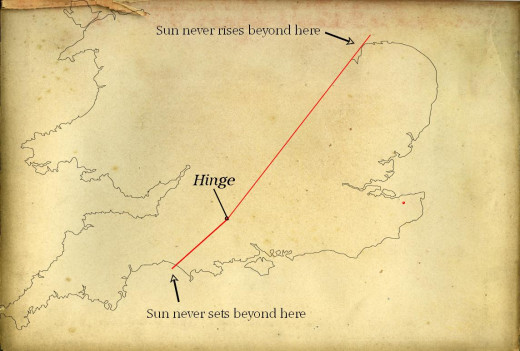
They did note, however, that while the Day-Stallion (the Sun) never ventured beyond those particular-spots on the horizon (as viewed from the Hinge), that wasn't true of the other light - the Nightmare (the Moon). At certain times, once every eighteen years, She both rises further north than the Sun(!) and sets further south! She can do what He cannot!
And this phenomenon can only be observed, marked and measured from one geographical-place, a very particular spot on the Plain of Salisbury. How did they work that out? I mean, we sophisticated modern's are only aware that Stonehenge sits in such a 'sweet-spot' because the ancients put it there, in that spot. If that device wasn't there on the Plain of Salisbury, we'd have no idea that such a 'sweet-spot' existed in Britain. And how would we find such a perfect spot?
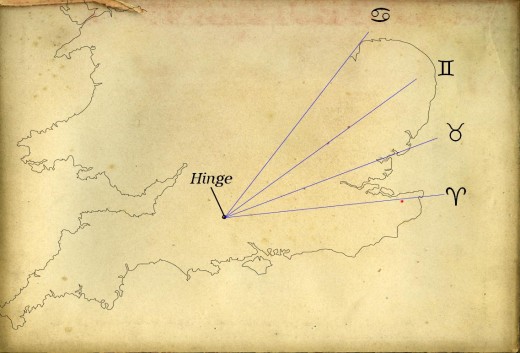
So that's my explanation for why, in Gemini, the influence of the sign doesn't always stop at the cusp-line's as drawn in me pictures - those cusps pertain strictly to the Sun's rising point on the horizon. Because the Lunar Standstill can only occur in signs close to the solstices (winter & summer) it is in Gemini that the cusp of the sign gets expanded a bit wider.
As you can see from my pretty-pictures hereabouts, that (seen from the Hinge) when the Sun enters and moves through the sign Gemini, in May and June every year, it's rising-point on the horizon aligns through Suffolk and Norwich, parts of Essex, Cambridgeshire, Bedfordshire, Buckinghamshire and Berkshire. Assuming you've read the previous instalments (if not go away and read them please) you'll know by now that these counties correspond to certain physiological bits-and-pieces - body parts and organs - of the gigantic, winged, betailed, hermaphrodite being within whose body we have our individual existences. I'd better put a picture in about here to help you make sense of what I'm babbling on about.
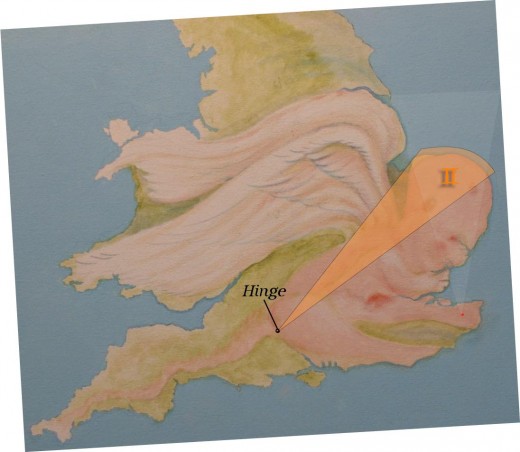
You can see that the 'beam' of Gemini passes through pretty-well every paired or twinned organ or limb in our giant's body - beginning at the Hinge (the anus) from where everything is measured, Gemini's 'beam' touches and/or illuminates the legs, kidneys, lungs, shoulders and arms, the ears... and the brain, seat of the intellect - very definitely Geminian.
But there's more. I have to leap-forward a bit here, 'cos I want to show you that from the other wheel - the wheel in the Weald in Canterbury, that the Gemini segment of the wheel goes to and converges with the Hinge alignment - in the hermaphrodite's head!
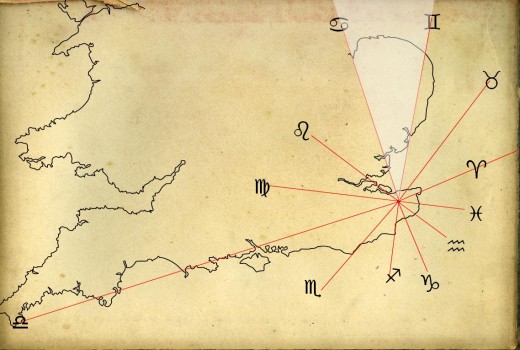
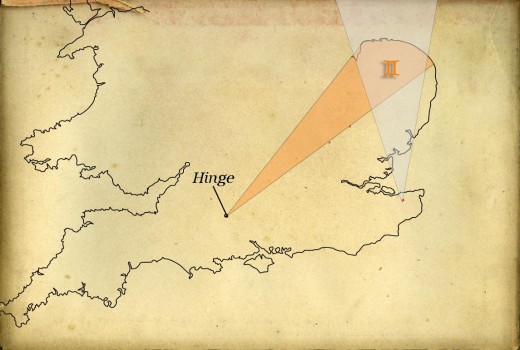
On the way to the brain and the intellect, you can see that the 'beam' from the ankle (Canterbury) touches the giant's hands, nose, eyes and ears. Where these beams of Gemini over-lap must-be - was - one of the most sacred ritual locations in all Britain. The treasures and artefacts unearthed in the region of the intellect say-so, unequivocally. It's hard to know where to start.
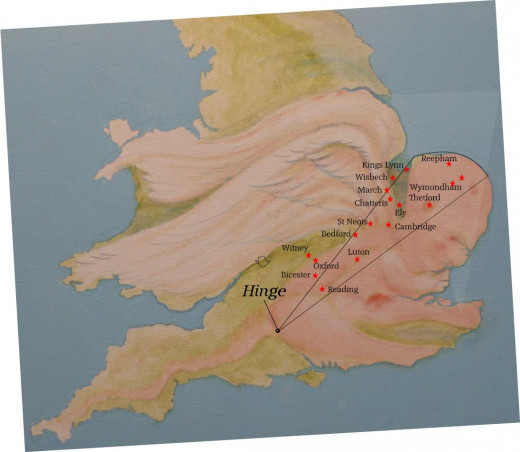
I'm sticking pins into the big voodoo doll more-or-less randomly, within the Gemini cone as drawn, but slighter wider to allow for the Lunar expansion of the cusp, as explained above.
Might as well start with the town called Bicester.
We pronounce the place-name Bister but we spell it Bicester - it must really confuse the Americans 'cos it still catches me-out and I always go to pronounce it as By-Sester - and that's almost bisector, to portion something. Bisect is just another way of saying divide, isn't it?
OK, so in truth Bicester doesn't spell bisect, but it's hard to think it was otherwise intended when you know, as we do and the place-namers knew, that Bicester is powerfully influenced by the bisected sign of the twins.
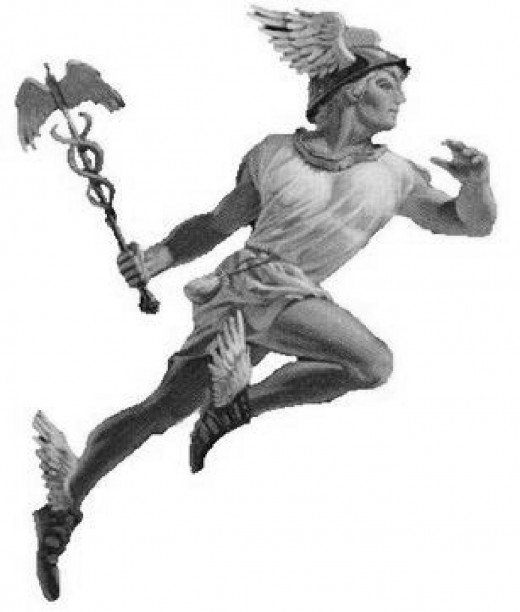
In Latin bi-cester means 2 forts.... the town is established as twin settlements on opposite banks of the River Bure. I hardly need tell you why that's perfectly appropriate. There have been many other variants on the name through the centuries including Berncestre, Burencestre, Burcester, Biciter and Bissiter.... hmm.... there's an old word in the Anglo Saxon that would not have been considered by orthodox toponymists simply because it doesn't seem to make any sense - the word is 'bisaec' and that means a wallet. Rather than explaining the significance of that I'll paste another picture of winged Hermes/Mercury here - with his pouch (wallet) attached to his belt in plain view.
Any road, in the 1086 Domesday Book, the town's name was recorded as Berencestra. The Anglo Saxon word 'berenian' comes close to the prefix 'beren,' and that means: to mount (with silver), and to ornament - a reference to quick-silver, that is, Mercury?
Gemini: The Intellect
Ruling planets: Mercury and Venus
Totem: The Twins or the Brothers; Duality;
Orientation: North, north east
Body: Arms and hands; frontal-lobes of brain; the nervous system
Time of day: 10am - noon
Time of year: late spring, Whitsun (Pentecost)
Third House: The mental powers; reason; written and spoken word; the local environment; brothers and sisters; relatives etc
Element: mutable air
Metal: mercury (quicksilver)
Tarot Arcana: 6, The Lovers or Brothers
Oxford in 1890
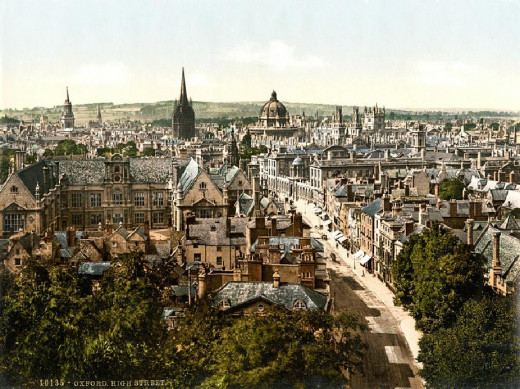
Not far off is Witney, and straight-away we're into the wits, undeniably of the intellect, and Mercury, aren't we? When It was first writ in a Saxon charter of 969 it was 'Wyttannige.' I'll look it up in the Anglo Saxon dictionary, as usual, to try and define its intended meaning. The prefix 'wytt' is 'wit,' and that means, incredibly, we two.
I'm sure that, at this early stage I'll not need to remind anyone why we're looking at these place-names in the first-place, though I will anyway. We're looking at these place-names in this sector of the landscape in order to see how they relate-to the sign of The Twins. Thus and hence we two is exceedingly fitting, appropriate, right, bulls-eye. Closely akin to 'wit' are 'wita' and 'witan,' and these too signify things of Mercury and Gemini, in spades - 'wita' is a wise man, sage, philosopher, whilst 'witan' is to observe, perceive, know, be aware of, understand, to look, behold, see. I think I hardly need go on defining wit and wits - the landscape and the names upon it seem well capable of that on their own.
Next, we'll flit like winged Hermes across to Oxford - the City of Dreaming Spires - home of the University of Oxford, and cast my dim-wits about the place. The University is first mentioned in 12th century records. These colleges were established at a time when Europeans were starting to translate the writings of Greek philosophers. These writings challenged European ideology - inspiring scientific discoveries and advancements in the arts - and society began to see itself in a new way.
I have to say, you couldn't get more early education than that, could you?
Reading. The first clear evidence for the town comes from the 8th century, when the town was known as Readingum.
It'd be so easy to just go-along with the expert toponymists on the origin of the name and s'pose them to be right when they say that it's just (as always) the name of a chieftain and the place was named Reada's People or some such nonsense. If anyone can find any evidence whatever confirming the existence of such a being called Reada after whom the place was named, I'll eat your hat (mine's too nice).
Given that Reading aligns with the rising Sun as seen from the Hinge during May and June in the sign Gemini, we have to take that into account when trying to get-at what the people who named this place were intending us to understand. Because reading and writing are - as previously delineated - talents or skills we are taught, specifically the domain of Gemini.
Anglo Saxon dictionary
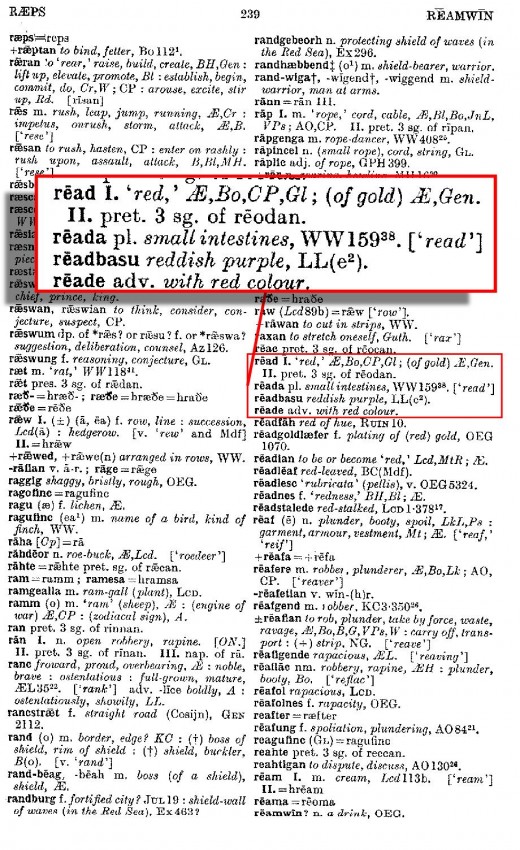
The alchemists considered Mercury the First Matter from which all metals were formed. They believed that different metals could be produced by varying the quality and quantity of sulphur contained within the mercury. The purest of these was gold, and mercury was called for in attempts at the transmutation of base (or impure) metals into gold, which was the goal of the alchemists.
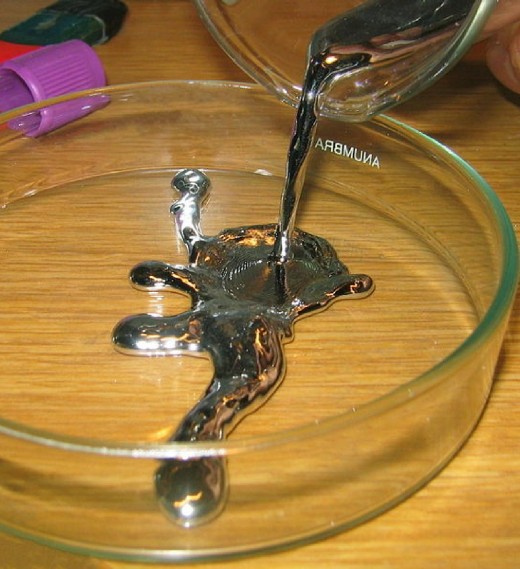
So, as you can see from the page out of the dictionary (right) 'read' and 'reada' means in fact red and redden, as you may suppose (or not), and it is also the word for the small intestine, as you can see. That seems a little-odd, doesn't it? What could the colour red be about, and how would it relate to the sign under investigation, Gemini?
It's because, I believe, quicksilver or Mercury comes from a vermillion coloured ore called red lead or cinnabar. Mercury occurs in deposits throughout the world mostly as cinnabar. In Latin lands cinnabar was known as 'minium,' meaning red lead.
Reading then is a very cleverly conceived place-name, isn't it.
And why would intestines be appropriate here? Are they?
Of course they are. A quick glance at me amazing picture of the giant-winged-infant (artist Mick Hill) who I'm calling Hermes for the duration of this article, reveals whereabouts Reading is located within the big-hermaphrodite's physiology. I would guess - not being a doctor - that Reading told our antique forbears exactly what organ they were sojourning in - the small intestine of the one associated with cinnabar, Hermes. The landscape and the place-names upon it were the ancient's guide-book to the three-worlds.
In terms of Gemini's and Mercury's 3rd-house, neighbourhood, friends, chatting, socialising influence, Reading has - since 1971 when it moved from Plumpton in Sussex - been home to the world-class music festival known as the Reading Festival. Every August thousands and thousands of music-lovers descend on the town in camper-vans, buses, benders, tents and cardboard boxes for a three day rave-up.
Y'know, I'd love to be able to take a poll of the attendees at the festival, and find-out everyone's zodiac-sign. I wouldn't mind placing a bet on discovering a very-high proportion of the Reading Festival audience fall into the sign Gemini. I mean about 75% of them.
Sounds ridiculous dunnit? But I've done it before - on a road-protest camp. One afternoon we had a rave-up in the woodlands we were (successfully) defending, Convicts Wood as it's known, and I, being known on-site as an astrologer, quietly asked each of the guests at the rave-up what their star-signs were. i did this because during the months previous I'd started to formulate these theories regarding the consciousness of the landscape and how it affected events upon it - the stuff you're reading now. So, as I knew at the time, this was (for me) THE perfect opportunity to research my ideas. So I was informally collecting data.
When I had completed my informal poll of the punks, anarchists, hippy's, pagans, vegetarians, vegans, carnvivores, students, teachers, musicians, poets, soliciters, ex-soldiers and travelling-folk who were there, I gathered a group of these environmental activist/eco-warrior comrades together on one-side of the glade, and told them I had something that would freak-them all-out. I passed the talking stick to 'X' as I asked her star-sign for the 2nd time that afternoon, and puzzled-like she replied 'Gemini.' I prompted her to pass the stick round the group and each revealed their star-sign as it was passed to them. In that gathered-group were 27 folks and 23 of them were the same star-sign - Gemini!
I have to say it - it DID freak them all out, even those who hadn't taken the mushroom tea. After everyone got over the shock, they all wandered about in the woods asking the others what their sign was. Believe it or not (and we all couldn't believe it!), the percentage of Gemini's to non-Gemini's in those woods on that road-protest was roughly 7 to 1, a most unexpected result.
For the rest of the month it became a major talking-point around every camp-fire and in every bender, and there were quite a lot of those. No-one could come on that site without being interrogated about their birth-sign, it was most interesting, a source of deep discussion among the folks in the various camps along the route.
After a few run-in's with the police and security squads on the site, the Magistrates put an 'exclusion zone' order on me, and I couldn't go near the site any more, so some of the good-folks would come and visit me for a bath or wot-not from time-to-time, and I was regularly up-dated on the 'sign-thing.' It would go something like: we've had five new pixies (environmentalists) come on site this week, they're living in the Flat-Oak tree-house and three of them are Gemini.
I tell you, no-one was as surprised as me. According to my amazing and incredible calculations, the area of landscape and woodland we were trying to preserve falls within a Geminian sector of the landscape (I'll show you this area later).
So that's why I go around at gatherings asking people for their star-sign. Lots of people think I'm a sad individual with nothing to talk-about, falling back on conversations about the weather and the reliable old-chestnut of star-signs. But that ain't it - I'm a soddin' genius. My Mum said so.
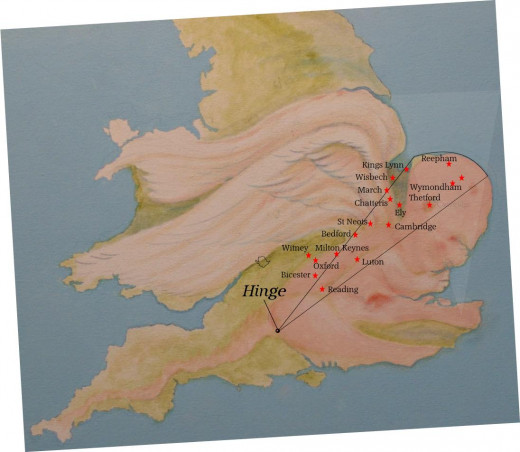
Vauxhall Motors griffin
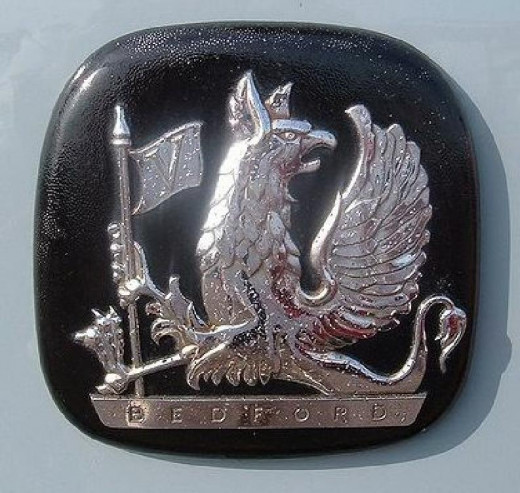
Bedford Ambulance
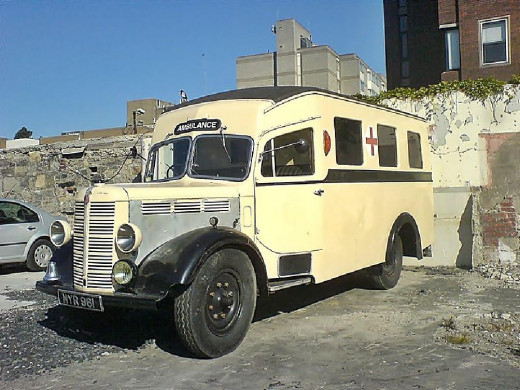

Cavalier


nice titfer

Luton in Bedfordshire fits into the Gemini zone too - in a big way - located up-there near the shoulders and upper-arms of our big-un. The town is the headquarters, and has been since 1905, of Vauxhall Motors, and one of their big-old car factories.
They started making motors in 1903, and their vehicles have been driven all over the local-environment and the neighbourhood by countless millions of friends, loved-ones and relatives ever-since. The third-house of local travel is ruled by Gemini and Mercury, and Bedford and Luton are right in that local-travel sector.
The company is currently headquartered at Griffin House, named after the Vauxhall Motors badge, a griffin.
Griffins have a lion's body, an eagle's head with erect ears, feathered breast, the forelegs of an eagle, and claws. The combination indicates intelligence and strength. In antiquity it was a symbol of divine power and a guardian of the divine.
Some have suggested that the word griffin is cognate with cherub - I of course believe that the cherub is our landscape in the guise or raiment of Hermes/Mercury, the fleet-footed.
Having this emblem of a griffin affixed to a fleet-footed vehicle is a sort-of protective-mandala - similar to those gaudily painted Indian buses covered with AUM symbols and beautiful images of the gods - to magically protect and watch-over the passengers and the vehicle, and clear obstacles from their path. All vehicles have some image or emblem associated with them and they are clearly magical in intent. And powerful.
The town was once more famous for hat-making - I must here remind the reader about that character in that book by Lewis Carroll, the mad hatter. He, and many other milliners, were sent mad by accidentally inhaling Mercury-fumes in the process of making those hats. And as I mentioned earlier, Gemini's intellect is where that manifests. We'll be coming-back to Lewis Carroll later-on.
The 'education' vibe seen in Oxford is still with us - the University of Bedfordshire is based in the town so of course the town is full of students, and students are governed by Gemini and Mercury.
The blindly orthodox teach that the town of Bedford is named after some great chieftan or other, some bloke called Bedu - what they don't tell you is that 'bedu' is an old word meaning battle. Put 'folm' rather than the bog-standard 'ford' on the end and the word beadufolm appears, meaning battle hand. This is astrologically intelligible as Gemini rules or governs the arms and hands.
Moving across the zone, we find a place that could be named after a poet and an economics theorist - John Milton and John Maynard Keynes respectively. Well, it's not really named after those two, though it would be extremely appropriate to Mercury etc, if it had been. Milton Keynes is a city-sized new town with a double-barrelled name it got from one of the eighteen little villages it subsumed.
Milton Keynes was originally known as Middeltone (11th cent.); then later as Middelton Kaynes or Caynes (13th cent.); Milton Keynes (15th cent.); and Middelton Gaynes (17th cent.). The 'Keynes' part of the name was added after the Norman invasion when some Norman's - the de Caynes - took-over the village, so I won't bother interpreting that part. But it's a town with twin-names - Milton and Keynes - and that's Geminian in it's own right.
The earliest spelling of the town's name was Middeltone, from Anglo Saxon 'midlian,' and that's an appropriate Geminian prefix, as it means to divide, halve. Cognate words 'mid' and 'middel' are equally fitting: 'mid' is in company with, in conjunction, together with, and 'middel' says in the middle, centre. You'll see straight-away why these are references to Gemini, the brothers or twins, and its dualing qualities, with no need of further explanation from me, I trust?
In Milton Keynes is Bletchley Park, known as Blechelegh in olden-times. This means - believe-it-or-not, black and white, the twin pillars, di-poles or binary-code of Gemini. 'Blec' is both 'blaec,' black, and 'blaece,' bleach, which we all-know makes things turn white. This is doubly-appropriate because Bletchley Park was the MOD headquarters, during WWII, of the code-breaking establishment that cracked the Enigma Code. It currently houses the National Codes Centre and the National Museum of Computing.
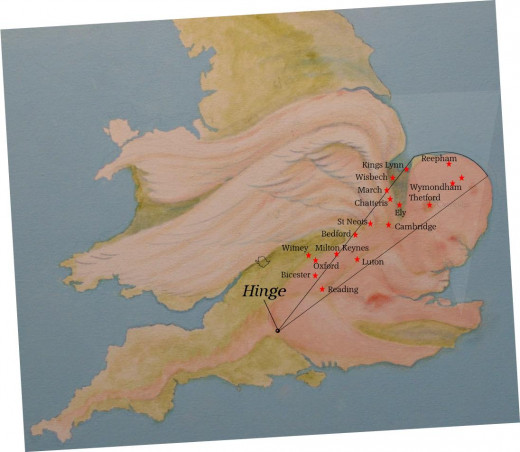
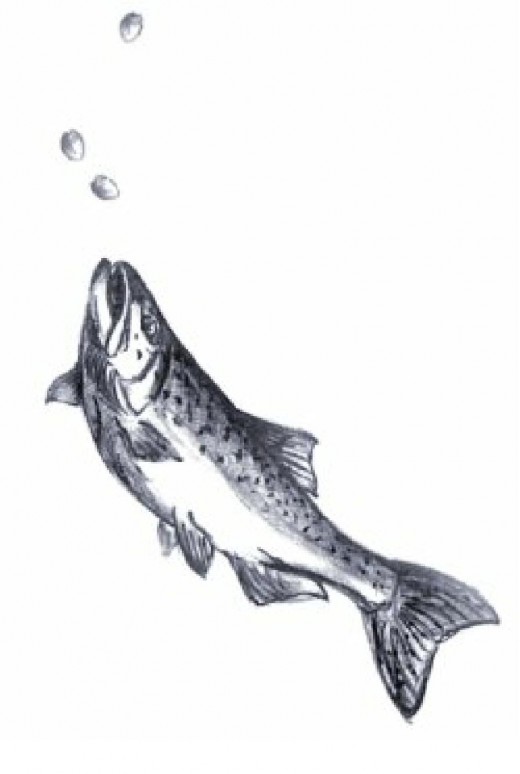
St Neots is named after the 9th century Cornish monk - the patron saint of fish - whose bones were stolen from Bodmin Moor and concealed in the nearby priory until that Henry VIII fella smashed-up the place and dem-bones is gone forever. St Neot, while alive, worked at Glastonbury Abbey as a sacristan - he looked after the room where all the parish records were kept. Well.... I have to say it - that's a Gemini thing, record-keeping. And having his bones nicked by naughty monks from Cornwall, who were then pursued across the country by a bunch of pissed-off brothers trying to get them back is er.... tricksy, innit? Even - dare I say it - knavish behaviour and plain tom-foolery. Mercury/Hermes would have helped those knavish-monks and protected them from harm because he is, as mentioned earlier, the protector of thieves.
The fact that St Neot is the patron saint of fish is interesting too - Mercury, the messenger, is often compared to a slippery, silver, darting fish that brings a message or symbol from the gods into the conscious mind. In the clear pools of reflective thought, the silver-salmon of inspiration rises up from the darkness in the depths of the unconscious-mind, and in a flash of silver darts across the surface illuminating the conscious-mind, and then, just as mysteriously, darts back whence it came.
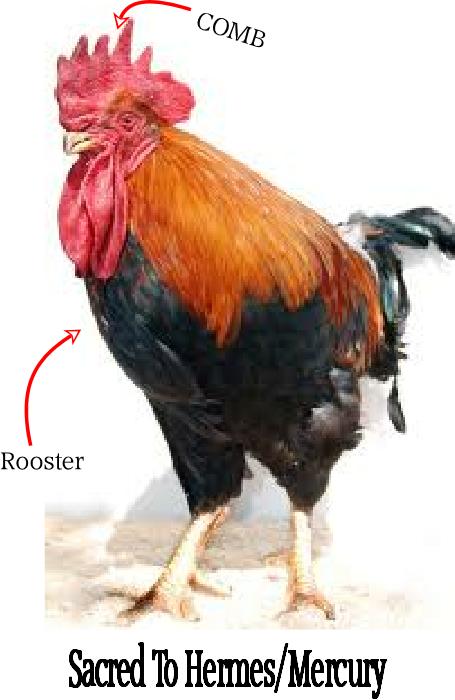
The educational theme continues apace as we wander-about in the Gemini sector of the English landscape, for also here we find another famous university town, Cambridge. The university was founded in 1209 and is ranked as one of the top 5 university's in the world.
The city stands on the River Cam where it took its name from. This is one of those place-names that would fox the most devout toponymists, to them it would make no sense whatever. In our old tongue - the tongue that named the places in England - 'camb' was the way they spelt comb; crest. Of course this is meaningless unless you know the area is sacred to Hermes-Mercury, and one of the gods' totem animals is the rooster.
I'll remind you about Hermes symbols - for they are many - the rooster and tortoise, a purse or pouch, winged sandals, winged cap, and the herald's staff or caduceus held in hand.
A god of boundaries and the travellers who cross them, he was the protector of shepherds and cowherds, thieves, orators and wit, literature and poets, athletics and sports, weights and measures, invention, and commerce in general.
Anglo Saxon dictionary
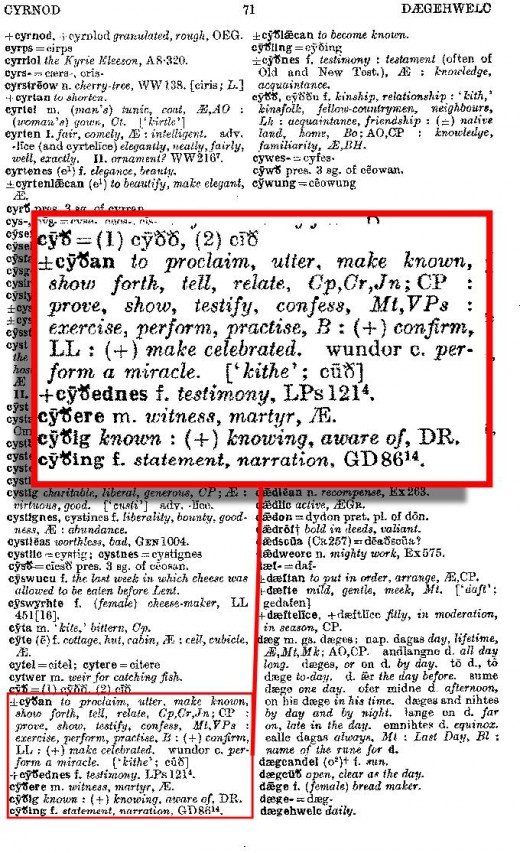
Chatteris was in the Domesday Book as Cetriz and Cateriz - but before we try to decode the old spellings I have-to make the remark that chattering and chatter are distinctly vocal - the spoken (and written) word is Mercury's and Gemini's domain.
Looking-up the prefix's 'cet' and 'cat' in the dictionary, it tells me the word = 'cyth,' so I look-up 'cyth' and it's virtually the same meaning as the modern chatter of Chatteris. I've copied and pasted the relevant page from the dictionary here on the right.
It means, I: to proclaim, utter, make known, show-forth, tell, proclaim, relate, testify, confess, statement, narration;
II: Known, knowing, aware-of;
III: perform a miracle!
Then there's the suffix to investigate, 'eriz' or 'eris.' In Anglo Saxon most things that start with 'e' and 'r' are all about the ears, which they spelt 'ers,' so 'eris' and 'eriz' means ears.
As we'll see a bit later-on, 'ears' stick-out in this region quite a lot, and for at least two good reasons. One of them is that Gemini is the sign of the spoken word - therefore the heard-word, therefore ears. And the other reason is that, as you can work-out by-now, this Gemini sector of the English landscape is the sector that contains the landscape Hermes' ears, which we'll get to in a while.
Anglo Saxon dictionary
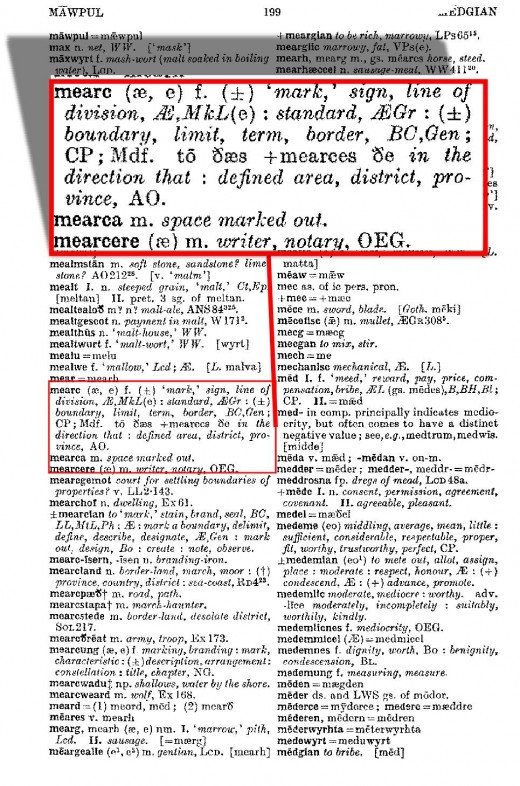
Ely
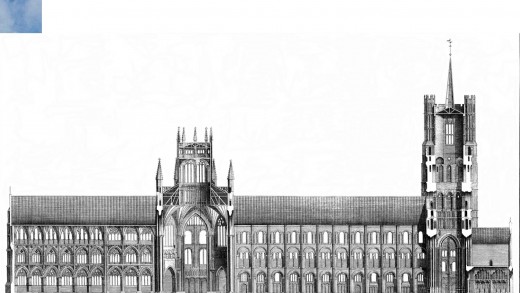
Let's look now at the town on the Isle of Ely called March.
Before the ancient land-reclamation of a vast area of the Wash, and the subsequent Medieval draining of the fens, the town was on an island in the bog.
Before we go any farther, I just want to draw on the idea that the ancient Ely islanders probably imagined the little island to be a tortoise, because the shell-backed vegetarian reptile is one of those totems of Hermes/Mercury, along with the rooster.
A glance at my maps shows how-far inland The Wash used to extend - all the way to the island of Ely, which is now 27 miles inland. The tortoise - I mean - the island is formed of clay and rises some 20ft above the mire.
March was formed from two settlements, Merche and Mercheford. Well, there's that old twin-thing again, to begin with.
The experts - espying the topography around March - divined the 'mer' prefix to be reference to the mire all around, mere meaning lake and mer meaning sea. And on one level they are right, but as I sometimes remind my reader, in the ancient view of reality there were three worlds, and place-names were designed to reflect all three.
I've gone and pasted another page from the dictionary hereabouts to show that 'merche' is 'mearc,' and, among other things that word means a writer or notary; how appropriate can it get? But there's more: 'mearc' also means (among other things) a line of division. The line of division makes sense in more ways than one, of course, so I'll only interpret the less immediately obvious bits.
The line of division is the place where the Sun turns around and reverses direction, the Tropic of Cancer/Capricorn, encountered at the division-line between this sign and Cancer. You'll recall, I hope, that Hermes/Mercury is the god of boundaries and a guardian of the travellers that cross them.
In my book (available on Amazon) The Humanoid Landscape (go and buy it), I relate how the ancient peoples around these parts (England) believed that The Isle of Ely was one of the entrances to the Underworld. That's why there's a bloody-great twin-towered pile of stones plonked over the entrance.
Ely ain't any-old island though, it's an island with its own cathedral. They've had a spot of bother, over the centuries, with the building falling down, and those Danes didn't help much either - they destroyed it in 870. They weren't worried though.... they rebuilt it and stuck a ruddy-great octagonal tower in the nave, and stripe-me-pink, along comes that bad-fatboy Henry VIII, and did the nasty to it, mashed-it into pieces; I think that this time they were quite-worried, so they all buggered-off and it lay there in ruins.... until someone-or-other rebuilt and restored the old-pile, from 1845 to 1870. Nice-work fellas.
At the Summer Solstice it is over The Wash and the cathedral at Ely that the Sun pauses in his northward travel, and rises in the same spot for three days in a row. As I've said, in the mind's of the hinge and circle-builders, this was very, very significant.
Also of huge importance and mind-bending significance was the fact that he would go no-farther than this chasm - here at The Wash the sun-stallion shies and turns-about, galloping south again!
That is some boundary.... and the Sun is some traveller, huh?
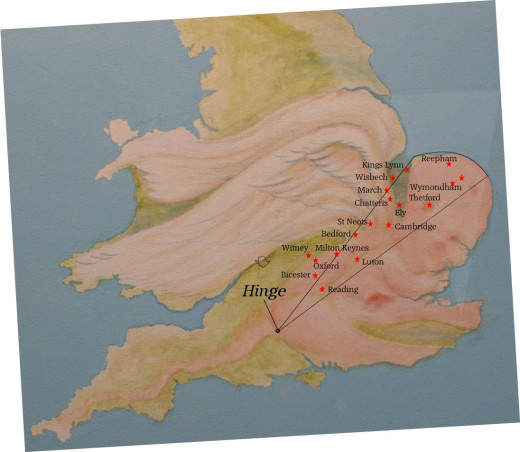
the Elysian Fields
These are two in number, separated by a very narrow strait; they are ten thousand furlongs distant from Africa, and are called the Islands of the Blest. They enjoy moderate rains at long intervals, and winds which for the most part are soft and precipitate dews, so that the islands not only have a rich soil which is excellent for plowing and planting, but also produce a natural fruit that is plentiful and wholesome enough to feed, without toil or trouble, a leisured folk. Moreover, an air that is salubrious, owing to the climate and the moderate changes in the seasons, prevails on the islands. For the north and east winds which blow out from our part of the world plunge into fathomless space, and, owing to the distance, dissipate themselves and lose their power before they reach the islands; while the south and west winds that envelope the islands sometimes bring in their train soft and intermittent showers, but for the most part cool them with moist breezes and gently nourish the soil. Therefore a firm belief has made its way, even to the Barbarians, that here is the Elysian Field and the abode of the blessed, of which Homer sang.
Plutarch, Life of Sertorius
The earliest record of the place-name is in the text of Bede’s Historia ecclesiastica gentis Anglorum, where Bede wrote Ely as 'Elge.' In Anglo Saxon 'el-' is a prefix in words that denote something foreign and/or strange. The 'g' in the old word would have stayed silent so the pronunciation of Ely was much as it is today.
The evidence that suggests (to me) that the ancients believed Ely Isle to be an entrance to the Underworld lies, as usual, partly in the place-name itself, and partly in its location in relation to The Hinge and the Summer Solstice pause of the Sun. You see, Ely is the suffix to a few ancient place-names and ideas associated with those place-names left to us by the ancient Greeks, but which, I believe, came from the English landscape and English concepts. The ancients Greeks called the Underworld Elysium and/or the Elysian Fields.
As you probably understand, I'm not a strong-believer in 'coincidence.' I, for-one, do not believe it a 'coincidence' that Ely and Ely-sium bear identical letters in their names, in the same-order.
Admission to Elysium was reserved for mortals related to the gods and other heroes. Later, the idea expanded to include those chosen by the gods - the righteous, and the heroic, where they would remain after death, to live a blessed and happy life, indulging in whatever they had enjoyed in life.
The Elysian Fields were, according to Homer, located on the western edge of the Earth by the stream of Oceanus. Hesiod the poet referred to Elysium as the Fortunate Isles and The Islands of the Blessed, located in the western ocean at the end of the earth.
Octagonal framework
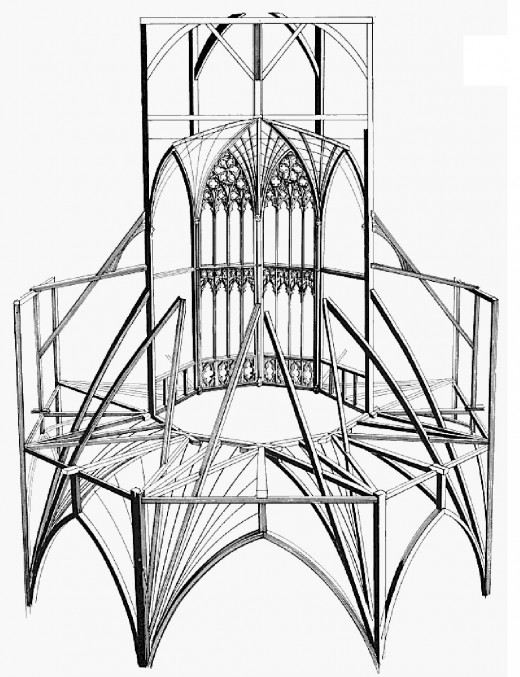
The octagonal tower on the cathedral is significant - it's a symbol representing eternal life - because the number 8 is symbolic of renewal. Many sacred buildings were designed with octagonal structures supporting a dome on top. This interplay between circle (dome) and square (found in the angular octagon) speaks of the transitional dance between earth and heaven - the heavenly twin and the earthly twin. The circle of the dome represents the heavens and the angularity of the squares in the octagon is symbolic of earthly presence. This is a concept that many ancient orders were aware of and speaks volumes vis a vis the heavenly, Geminian influence on this particular region of the landscape. It is a connecting-point between the worlds - the heavens and the earth, the heavenly, immortal twin and the earthly, mortal twin.
Now,,,, because we now know of the presence of our landscape-Hermes, the once simple Geminian equation: heavenly being +- earthly being, gets slightly more complex, I think. Because, y'know, our landscape Hermes/Mercury is most certainly angelic, inasmuch as the possession of wings, and in human terms is relatively immortal , inasmuch as Hermes/Mercury in the land is made-of the land itself - and the land IS immortal, huh?
And yet..... because of the fact that our immortal, hermaphrodite, winged-one IS the land itself, IS the Earth.... then, heaven and earth are not divided, if you see what I mean? WE live within an immortal. We partake in immortality.
The Isle of Ely is actually located in the back of the skull of our winged-one - I think this is pointing-us to the brain, domain of Gemini - as well as, perhaps, the place where the mighty-one's massive-wings connect to his body.
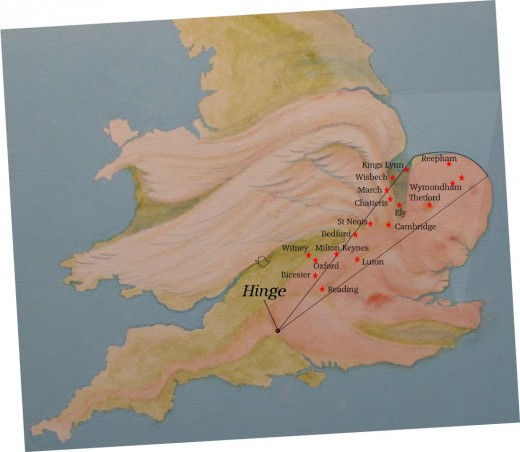
brain zones
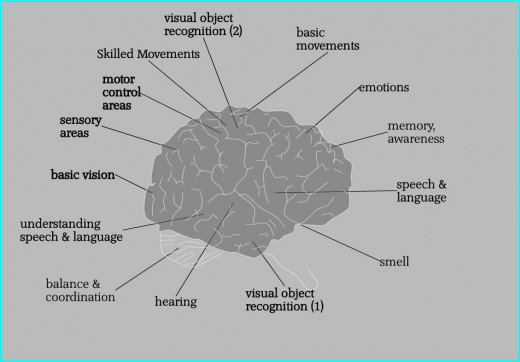
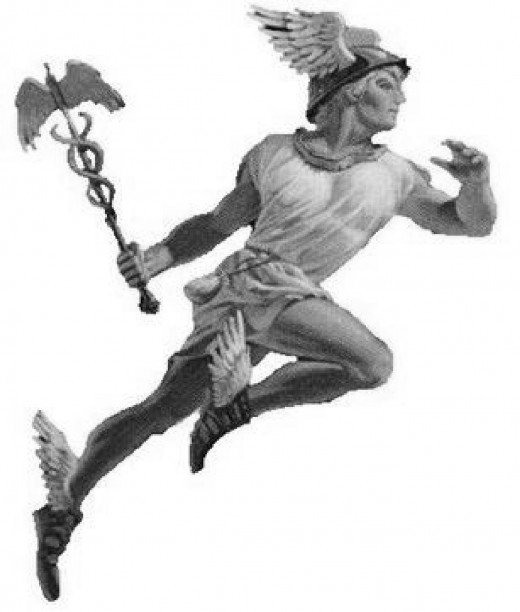
Wymondham Abbey
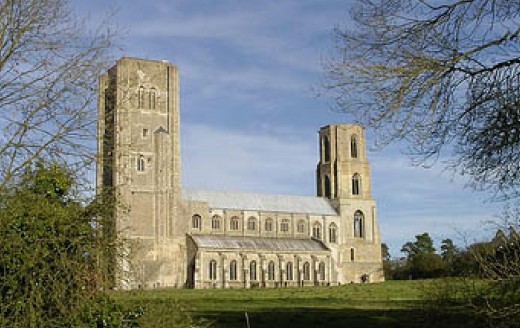
According to the brain-map (right) of the different regions of the brain and what they are each responsible for, this area called Ely inside the brain of the angel, corresponds to the cerebellum - responsible for some very Geminian (and winged) faculties of being - balance and coordination. Pretty neat, huh?
Finally, 'El' is the name of a certain entity, a dude we usually know as God (with a big G). The noun ʾēl was at the top of the lists of ancient gods and El was known as the ancient of gods or the father of all gods. His name shows up everywhere all over the ancient world in tombs, libraries and temples.
The bull was sacred to Ēl and his son Ba'al, and they both wore bull horns on their headdress. He's called Toru El (bull el or bull god) - creator of creatures, father of the gods, and father of man. He is called the creator eternal. El is in the Hebrew version of the Bible, quite a lot - for instance in Genesis 21:33 where ’ēl ‘ôlam translates as God Eternal.
And yet, after all indicators of immense sacredness, those expert toponymists still say that the place-name signifies nothing more holy than eels - they reckon that Isle of Ely means the Isle of eels!
Personally, I can only accept that that's the only meaning of the place-name if the eels they point-to, are the two 'eels' wrapped-around Hermes/Mercury's staff, his caduceus. Or if their 'eels' are reference to dragons and serpents, denizens and guardians of the Underworld. Or if those 'eels' are secretly referencing the serpentine-spinal-cord, because Ely is, as you know, located at the top of the spinal cord of our giant Hermes.
Jumping across to Wymondham (pronounced wind-ham) so that I can show you how this Gemini twinning pervades many of the important old buildings in these Mercurial regions of the English land. The actual pronouncement of the place-name, wind, suggests air to me, appropriate of course because Gemini is the 1st of the Air Signs, and speech is wind. Gemini IS the spoken word. To decipher the place-name we've got to go with the way it's actually spoken, as the current spelling 'wym' has no correspondent in Anglo Saxon. 'Windan' and 'wind' speak of moving air - wind - but also refer to something coiled, wound about, plaited, twisted - easy to decipher when you know that Wymondham is the hair on a giant's head. But, as ever, there's more - 'windan' also means jump, fly, swing, whirl, turn, roll. If that ain't a reference to Mercury/Hermes aka our bewinged infant in the land, then I don't know what is.
Alleged knaves and rogues have made their presence known in Wymondham.
Wymondham's most famous inhabitant was Robert Ket, who led a rebellion of peasants and small farmers - in 1549 - who were pissed-off about the enclosure of common land. They went round the countryside ripping-up the fences the gentry had put-up, and causing a lot of aggro for them. Later-on after him and his lads had invaded Norwich, they done-him for treason and then hanged him at the castle there.
The Great Fire of Wymondham - started by three gypsies - broke out on 11 June 1615 - that's the month of Gemini. Two areas of the town were gutted - there were two separate fires and about 300 properties were razed. The gypsies and a few other knaves were rounded-up and hung from a tree.
In 1785 a prison was finally built to deal with all this local ferment - as it turned out it was the first prison in Britain with separate cells for the prisoners. Very nice.
cock-head
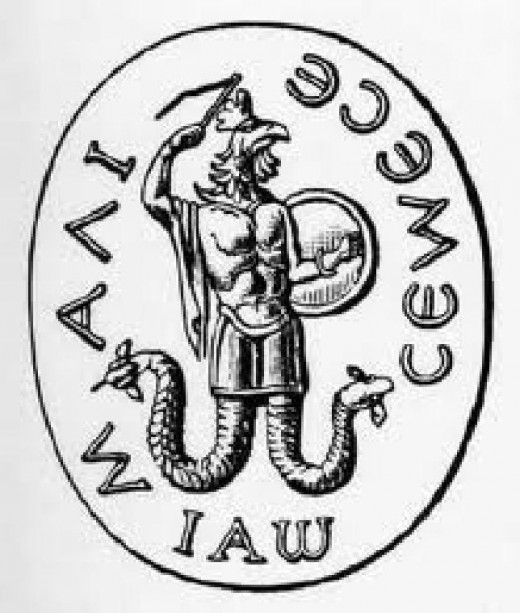
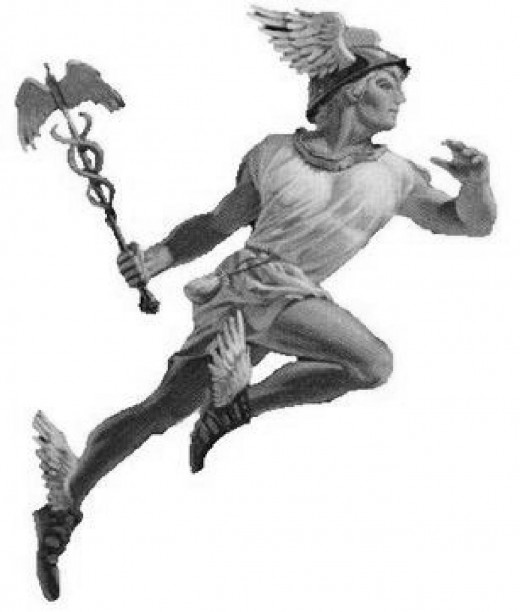
The town of Thetford is near-by - home-base of Boudicca's tribe the Iceni. In 1979, a hoard - the Thetford Treasure was located just outside of Thetford. It's a stash of thirty three inscribed spoons, twenty gold finger rings, four pendants, several necklaces and a 2" gold buckle depicting a dancing satyr.
One ring is set with an engraved gem, and a rooster-headed, snake-legged being is engraved on it. This image is found all over the world, the sacred-word Abraxas with it, a lucky-amulet.
Before looking at some of the other buried-treasures in Thetford, I'd like to take a quick-tour around the villages and towns near-to Thetford, for reasons that'll become-clear soon-enough - look at the maps and think ears.
Eriswell has that same 'eris' that we saw back there at Chatteris, where I suggested it means ears. I'm sticking with that, clearly, 'cos when we put ears and wells together in our minds-eyes.... a metaphoric lug-'ole? But there's more, quite a lot more.
Not far away is the village called Herringswell. The 'well' part doesn't need translation I'm sure, 'cos we all know what a well is, don't we. But, we wonder, why name a village after a fish in a well? Perhaps, we muse as if with one mind, given that the villages' name also has that 'erris' within it, it might signify that someone's got a good-set of lug-'oles, might'nt it? That someone's hearing well? Near-by is Lakenheath.
Lakenheath. Of course, Laken-heath is highly appropriate in various ways - and not only in terms of ears, but also in terms of flight, one of Hermes specialities.The biggest US air-force base in Britain is based here, at Lakenheath. 'Laeccan' is to capture, catch, receive; it is to comprehend, understand; and cognate 'laecan' is to rise, spring-up, flare-up.
Many of these places are within the parish of Weeting within which is the village of Weeting. The experts will tell you, should you bother to ask, that the place is obviously named after that commodity that the area is so famous for - wheat. This is, after all, the so-called Bread-basket of England. In one sense only I agree with them, but only in that wheat is famous too - for its ears. When referring to the yield of a crop the farmers would say something-like: 'we'll get many-ears of wheat from this field,' or something like that. But 'weet' means something more akin to the modern term wet. As Weeting IS behind our Hermes' ears, the old phrase to refer to something or someone as being very young springs-to-mind - the allusion is to the inexperience of a baby, so recently born as to be still wet. The earliest use to be found for 'wet behind the ears' is from the Portsmouth Daily Times, October 1911:
There is not much in the matter so far as the organ [the courthouse record] is concerned except it is so new that it is wet behind the ears yet.
My certainty that here in Thetford lie the actual, physical ears belonging to our landscape Hermes/Mercury, is caused, in large-part, by the presence of some very-odd tunnels and holes in the recently-planted (1920) Thetford Forest. I've stuck a Google Earth gadget here, you can see how big these holes are (make sure it's switched to satellite) - who knows how many were over-planted(?) with the incredibly ugly, deadening, mono-culture tree-plantation that surrounds Grimes Graves, as the holes and tunnels are called.
But these are no graves - and they're no flint-mines either, as the experts have decided to erroneously label them. Well, they couldn't work-out what they were dug for, could they. They had to call them something that made some kind of sense.
Hopefully then, it will make perfect sense to my readers (you) when I make the insane-sounding statement that Grimes Graves are the lug-'oles of a mighty-being? Of course it will. Grim, not grime, was one of the many names the ancients called a certain god. In Anglo Saxon 'grim' signifies a ghost, and 'grima' means spectre.
The word graves descends to us from the word groves. Groves, as you know, are places of magic-ritual, spells and incantation.
Grim, as I said, is but one of the names for the Saxon's Creator-God, Odin/Woden, and this is Geminian-ly pertinent too, as Woden is one of the representative gods of Mercury, clever, wise, skillful etc, etc, a god of inspiration, poets, seers, and music.
Descent from Woden was an important idea in early Medieval England. Claiming Woden was an ancestor became essential in establishing royal status. No king by the late seventh century could do without the status that descent from Woden entailed. Richard North. 1997.
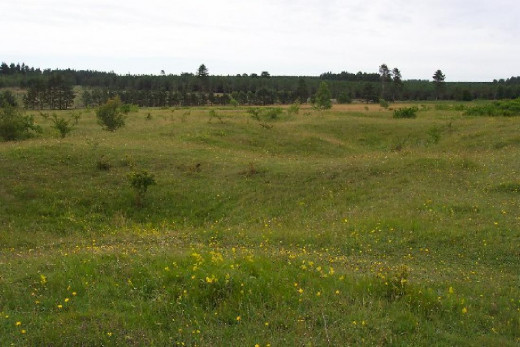
old plan of the excavated galleries
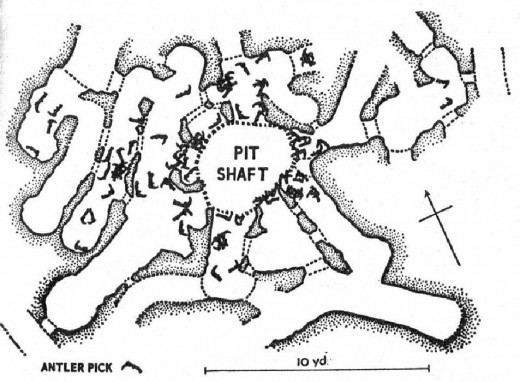
The experts call Grimes Graves flint-mines because at the bottom of each pit (there are more-than 400) lining the floors, is flint.
At the bottom of each pit (only one of which is excavated), are tunnels leading-off in many different directions - north, south, east, west and all-points in-between. The experts say that these tunnels followed the veins of flint that the 'miners' were after - again I wonder why the flint still lines the floor of the various excavated tunnels? If it's true that they dug all these pits and tunnels to hack-out flint, using antler-picks no-less, why did they go-through all-that aggro and grief? Why did they bother? Huh? The area now covered with Thetford Forest, and everywhere for miles and miles around has flint just lying-there on the surface, and all they had-to-do was pick-it-up. But they didn't. According to the experts, it's the wrong-kind of flint! Ha ha ha, you've got to laugh... wrong-kind of flint, ho ho ho, that's funny.
But no matter! That old flint lying there on the surface could just stay right-there, as far-as our flint-miners were concerned. They somehow-or-other knew that all they had to do was dig a 40ft hole in the ground, and the gods would provide! The right-kind of flint would be there! They just knew it. They picked-up their antlers and dug. Ten-feet down they came-upon flint! Hurrah! But no.... wrong-kind. Boo! Dig-on lads. They picked-up their antlers, and hacked through the flint. Twenty feet further down the hole they came upon flint again.... hurrah? Boo! More digging and, at last, there it was. To you-and-me that right-kind of flint was no-different in any-way from the other veins they'd hacked right through.
But to our prehistoric flint-miners, it was clearly, obviously different. It must-have-been, according to our experts, because that's where they stopped digging! And that's where they dug their radiating tunnels, following the vein in the floor, where the precious-flint still is.
Because it lays there, lining the tunnel-floors, our ever-ready experts have given the right-kind of flint a scientific-name - floor-flint.
They espouse that the 'special' flint was probably used for 'purposes we can't imagine,' with its special 'properties.'
You can see from the Google-Map thinga-majig that the holes or pits are clustered pretty-closely together. I imagine that the tunnels, radiating in every direction and at differing-depths, would have inter-connected with each-other. I imagine further, that the flint veins would exhibit some resonant properties when certain-sounds are made within the tunnels. I think of massed-voices chanting, at first, and how it would have resonated.....
But then I remember that I read an article some years ago (can't remember the author or the title) by a sound-engineer who'd been taking ultra-sensitive sound-recording equipment into prehistoric edifices such as Maes Howe and Stonehenge. He discovered that many of them exhibit ultra-low frequency sound-waves, generated by the wind interacting with the structures, and amplified by the structures themselves. These frequencies, though inaudible, match the brain-wave frequencies known to stimulate or induce states of altered-consciousness and trance, superconsciousness and ecstasy.
The flint-miners didn't transport all of the spoil from the pits and tunnels away, but piled it in neat banks all-around the openings of the pits. I imagine that they did this in order to generate those ultra-low frequencies in the complex beneath the ground. Those assembled within the tunnels would meditate in the silent-darkness and enter the mind of Hermes/Mercury - this - I believe, is how they tuned-into the mind of god. They were, after-all, sitting silently within the inner-ear of Mercury/Hermes.
We get our name for the place, Grimes Graves, from the Anglo Saxons, like 99% of all our place-names. The Anglo Saxons called it Grimes Grafen, or 'Graf,' which had been interpreted by the experts to only mean grave. But, like all of the old words, 'grafen' and 'graf' have more-than-one interpretation. 'Graf' is grove, and 'grafen' means carved, engraved, chiselled. Cognate 'grafet' is simply a trench.
None of which sounds like the name for a mine.... to my mind. I think that the ancient Anglo Saxons were astute enough to recognise an old mine-works when they saw one. But what they called it, is more-like..... a carved or engraved grove sacred to Woden, denoting, surely, a place of ritual and magic?
The district here is called Thetford, a place-name we should have a closer look-at too. The experts say that it was taken from the Anglo Saxon Theodford, meaning, they say, the people's ford. Well, I don't think I can go-along with that entirely... I mean, we all know, don't we, that theo means God.
In Anglo Saxon then, 'theo' means a number of things. Sure enough, it does mean the people, but it also means ordain, establish, fix, make, produce, create, play (instrument), string-up. Hmm. There seems to be some allusion here, towards making-sounds, does there not, musical-sounds, at that?
And. I have to say, the bit on the end, Ford, a shallow crossing-place on a river, whilst it works well-enough in context of Hermes/Mercury's guardianship over travellers and boundaries, also has another potential meaning. There are words that were put within ancient place-names that had no equivalent in modern English. To get around this problem (for census reasons, etc) they standardised place-name formats such that, if it started with an 'f,' for example, they standardised it into 'ford,'even though many-such places had no river anyway. I believe that such was the case here at Thetford, where there IS a river. I believe the word that was replaced in this particular case was a word I can only write in modern English - and it's 'ferhth,' I'll put a small image of it somewhere nearby. That word means mind, soul, spirit, intellect; eternally, forever.

Of Eutherios
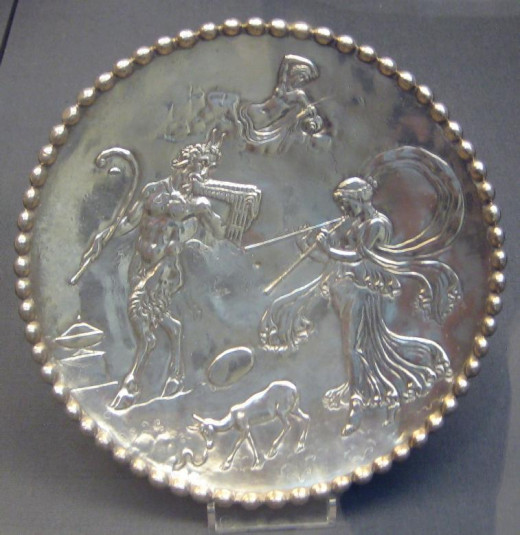
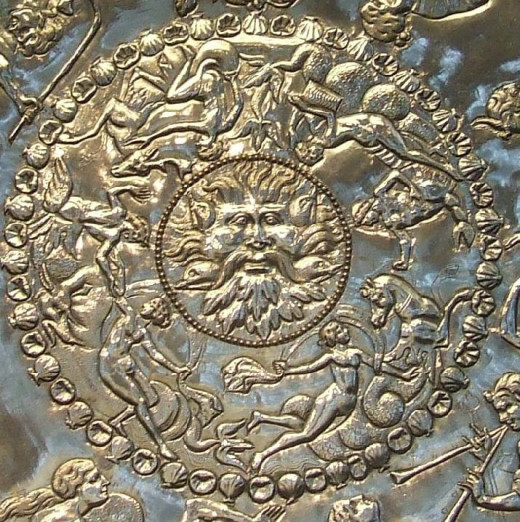
So, you can put all of those meanings together in any order you like, and I believe you'll find it says more, much much more, than the People's River Crossing.
Mildenhall is a place to have a look-at too, methinks - because of the treasure they found buried-there. It's some treasure this one, and there's some writing on it, engraved into the silver on one of the small platters. The experts dismiss its message as 'ownership graffiti' - it says 'of eutherios,' but I dismiss the experts and their overwrought 'opinions' and summaries. That ain't no graffiti, I tell you - as plain as the nose on my face that of eutherios is a message, and it can be read.
Aether is an ancient concept, its like what we might call god's breath. According to Dictionary Dot Com it is: ♦ the upper regions of space; the clear sky; the heavens ♦ the medium supposed by the ancients to fill the upper regions of space ♦ in physics. a hypothetical substance supposed to occupy all space, postulated to account for the propagation of electromagnetic radiation through space.
In Anglo Saxon 'eth' means breath, breathing.
The suffix is one we've seen several times already, 'erios' is 'ers,' that is ears.
So, here's what the message is saying: 'of' offered (an offering); 'euthe' breath, air, sky; 'erios' ears.
I guess then that, displaced as it might be from it's original site of sacrifice, that all this fine silverware and craftsmanship was a 'gift' to our landscape Hermes/Mercury - on the breath, through the sky, to the ears, a prayer in silver.
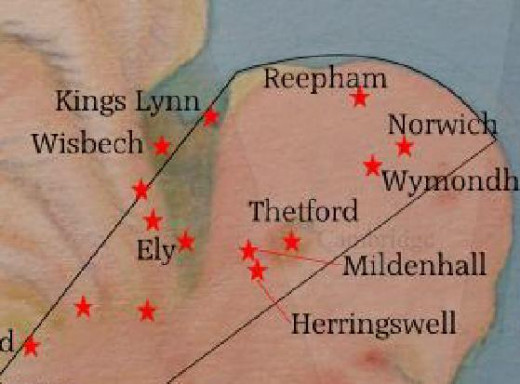
the undivided....
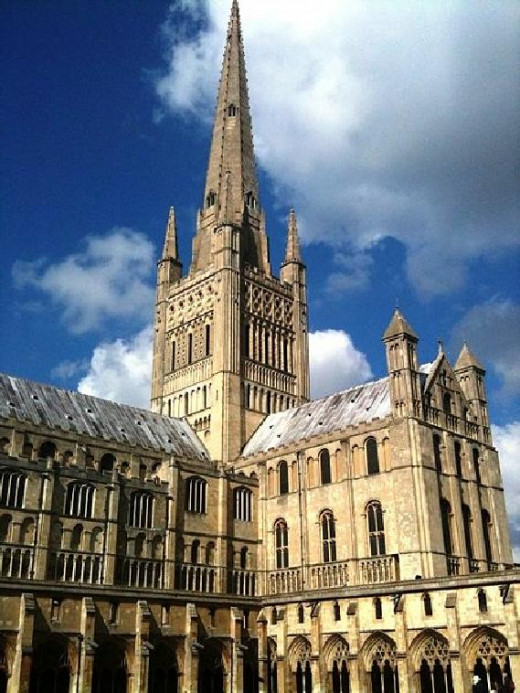
Wensum
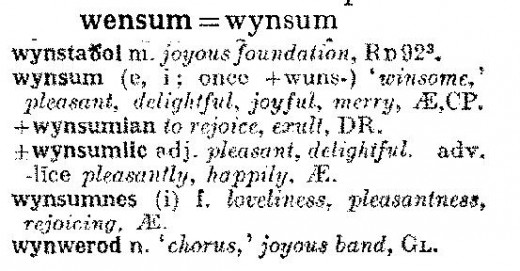
The fact is, East Anglia is literally stuffed-full of precious objects, more than most other regions of Britain. Many are yet to be found, they're still waiting to be uncovered in their bury's. The reason the ancients chose to make such spectacular offerings in Anglia is, I firmly believe, because they were well-aware that actually, it's the gigantic head of a winged hermaphrodite 'god.'
Moving on now, to our fourth university-city in the Gemini zone, Norwich, a place renowned for its accent, and its university, where they specialise in creative writing, and that's very Mercurial/Hermetic/Geminian, if I do say-so.
Around these parts the place-name Norwich is pronounced variously norritch, norridge, and naaridge. It sounds uncannily close to that other mercurial speciality, knowledge. If you asked one of the locals to say the words 'knowledge' and Norwich you’d hardly be-able to tell the difference. In fact, all of East Anglia is notable for its regional twangs or accents, something to put-down to the word-smithy himself, that Mercury/Hermes, I'll avow.
The experts reckon it started-out as a couple (or three) little villages on either-side of the river Wensum, and then gradually morphed into the town it is now. Apparently, the one's we call the Anglo Saxons settled on the site of the current city from the 5th to the 7th centuries, founding Norvic (where Norwich gets its name), and Westvic (now called Norwich-over-the-Water). The ancient city was a thriving centre for trade and commerce in 1004 AD when it was raided and burnt by Swein Forkbeard the Viking. Well, he WOULD be a forked beard wouldn't he, in the sign of the twins.
Norwich Arms - the twins
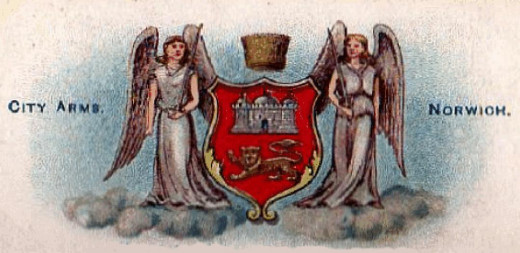
According to the Domesday Book Norvic had 25 churches and population numbers of 5-10,000. The Normans built a cathedral in 1096, in Norvic - the bishop of Norwich still signs himself norvic - it's a very nice cathedral an'-all-dat, but it's the dedication of the pile that's signal - it's dedicated to the Holy and Undivided Trinity - the undivided. That's pretty-interesting, innit - in the sign Gemini, inside a giant-head, in the holy-city of Norwich's most treasured temple, the cathedral is dedicated to..... the Undivided Trinity.
Along come the devoutly Christian Normans, violently reacting against everything English and everything remotely pagan. And just thirty-years after they'd invaded they go and build this huge cathedral and proclaim it undivided. They must have discovered something about the region. It turns-out that Norwich has a long-history of religious and political division and factionalism.
The locals were not too chuffed with all that Norman nonsense, and they kicked-off big-stylee - there was a riot in 1274, and the Pope excommunicated the entire city.
Nice.
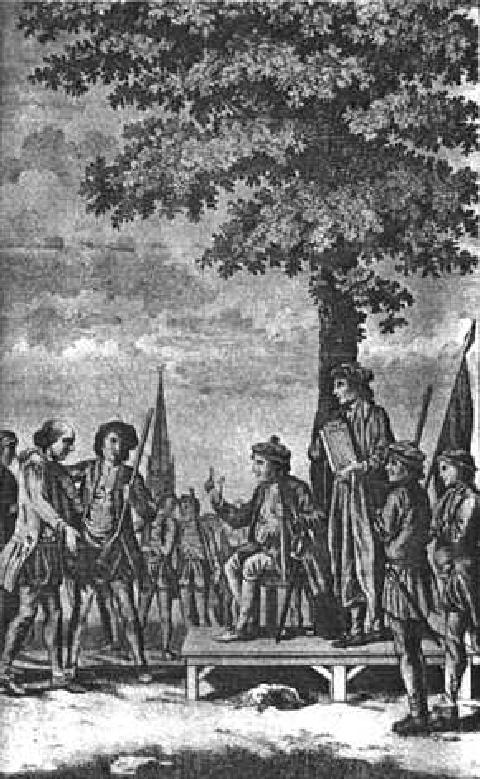
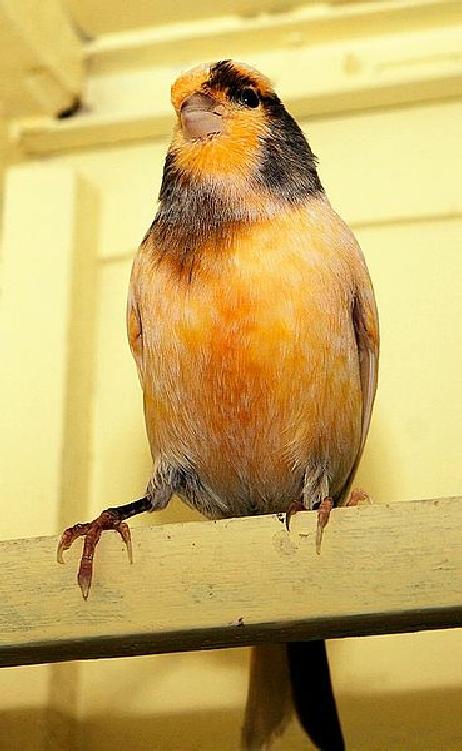
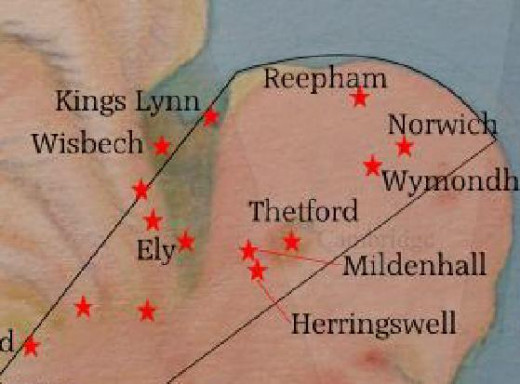
In the 11th century, Norwich was the 2nd largest city in the land, after London. Sometime in the 14th century they finished building the wall around the city, it's two-miles-long and the area inside it was bigger than London - they made it illegal to build anything outside the walls - you're either IN mate.... or you're OUT, well-out.... and no messing.
1549 saw a rebellion in Norfolk. Kett's rebels (we met him at Wymondham), went round ripping-up-fences that'd been put-up to steal common-land. They camped outside Norwich under an oak tree and soon took control of the city, with the support of half the locals. It is recorded that it divided the city.
Kett and his rebels had a confrontation-or-two with the opposition and then the army, and after some heavy-duty skirmishes, Kett was captured, chucked into the Tower of London, tried & found guilty of treason, dragged back to Norwich and strung-up at the castle.
After the shit-storm died-down, Norwich became the first city in England to make it compulsory for a city to make payments for poor relief, which lead to the Elizabethan Poor Law of 1597.
Norwich has a history of welcoming dissident minorities, such-as the Hugenot of France and the Walloon of Belgium in the 16th & 17th centuries, otherwise known-as the Stranger Immigration. The arrival of the Strangers in Norwich fostered religious reform and radical politics in the city.
A bunch of Flemish weavers arrived here too, with their advanced techniques and their pet canaries - only the males sing, making them more popular than the birds, err.... females. They bred so well here that eventually they became the city's mascot, ahh.
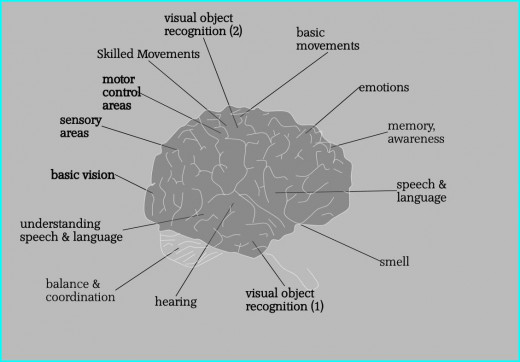
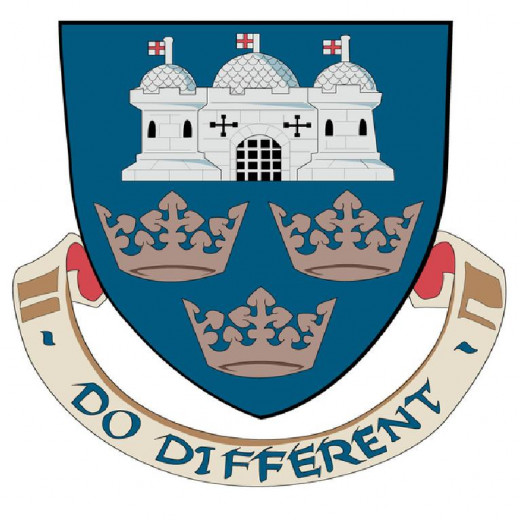
- Michael Andrews (1928–1995), 20th century painter.
- George Borrow (1803–1881), writer and traveller.
- Sir Thomas Browne (1605–1682), medical doctor, polymath scholar scholar, encyclopedist and philosopher, Biblical scholar and esotericist.
- Edith Cavell (1865–1915) World War I nurse executed by the Germans for helping allied prisoners escape.She is buried on Life's Green, on the east sideof Norwich Cathedral.
- John Crome (1768–1821) Joseph Stannard (1797–1830) and John Sell Cotman (1782–1842), founded the Norwich School of painters.
- William Crotch (1775–1847). Composer, artist and teacher. Known as Norwich's Mozart. He gave organ recitals aged 2. Played God Save the King for the King, aged three. Performed at every major town in Britain by age 7.
- Pablo Fanque (1796–1871), the first black circus-owner in Britain.
- Elizabeth Fry (1780–1845) prison reformer. Her portrait is on the 2005 £5 note.
- Joseph John Gurney (1788–1847) banker and philanthropist - active in the movement to abolish the slave trade.
- Julian of Norwich, a contemporary of Chaucer, a mystic, and author of The revelations of Divine Love - the first book written by a woman in English.
- James Martineau 1805–1900) philosopher.
- Harriet Martineau(1802–1876). Writings include Illustrations of political economy (1832–34). Translated writings by August Comte. Published Laws of Man's Social Nature (1851) and Biographical sketches (1869).
- Bernard Mathews (1930–2010), founder of the turkey company. I'm reminded that roosters are sacred to Mercury/Hermes.
- Bernard Meadows (1915–2005) sculptor.
- Sir John Mills (1908–2005) educated at the Norwich High School - also had trials with Norwich City F.C. in the 1920s before getting into drama.
- R.H. Mottram (1883–1971) novelist.
- Nelson (the Admiral) attended the Norwich School from 1767 to 1768.
- Mathew Parker (1504–1575) Archbishop of Canterbury.
- John Palgrave Simpson (1807–1887) prolific playwright.
- William Smith (1756–1835) Whig politician, dissenter and abolitionist, M.P. for Norwich from 1807.
the twins
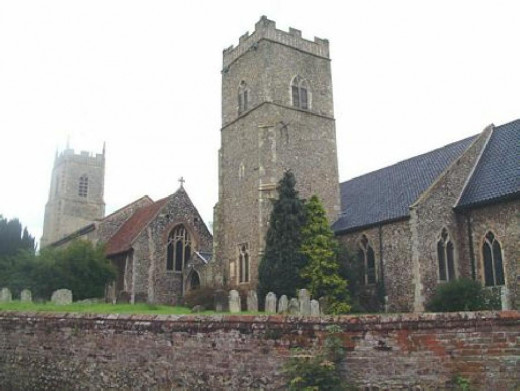
When we look at the regions of the brain where Norfolk and Norwich etc, are located (see images) we find that skilled motor movements, object recognition and emotions, memory, awareness, language, music, hearing are all involved.
Just-like the distinctly separate hemispheres of the brain, Norwich has always been the focal-point of East Anglia's equally-distinct two-sided religious and political traditions, since the place was first built. There is currently some discussion going on in the city regarding a new motto. England's Other City has been proposed, though it remains to be seen whether they'll go-for-it. If you ask me it's perfect - it's as Geminian as you could ask-for. It's like saying 'the twin' or 'brother' city - far-more appropriate than the current motto - Norwich, a fine city.
I'm no expert, but I reckon that the city is probably located at the place in the brain where the two hemispheres are connected-together - via a weaving web of fibres. It sort-of explains, don't it, the weaving archetype that's settled on the city since the middle ages?
I've copied a list of notable-type personages that have either been born in Norwich, or who were influenced very-much by being educated there - I've stuck-it alongside this text for your perusal.
In 1812, Andrew Robertson wrote to Constable, the painter:
I arrived here a week ago and find it a place where the arts are very much cultivated....some branches of knowledge, chemistry, botany, etc. are carried to a great length. General literature seems to be pursued with an ardour which is astonishing when we consider that it does not contain a university, as it is merely a manufacturing town.
Well, since the early '60s they have had a university - a list of the subjects they specialise in is very... err... appropriate for the sign Gemini:
♣ American Studies ♣ Film and Television ♣ Language and Communication ♣ Literature, Drama, Creative Writing ♣ Music ♣ Philosophy ♣ Political, Social & International Studies ♣ World Art & Museology.
The university's motto is typically, for Gemini, quirky, it is Do Different.
There are of course a trillion more Geminian traits associated with the city - I've only pointed at the most-obvious ones but have most-likely ignored many. But we've gotta move-on anyway.
The next location I randomly stuck-a-pin in the map was Reepham, a lovely-little village on the top of our giant's head that is notable for what are called its twin churches. Apparently there were three churches on the same-site until one burned-down in 1543.... it seems to me that, no-matter how hard the Christians tried to impose the notion of trinities onto everything 'sacred,' the underlying dualing of Gemini re-asserts itself by 'acts-of-god,' as they're known. And we know where that god lives, don't we? As the ancients did.
The village was in the Domesday Book listed as Refham. In our olde tongue a 'refa' is a high official, reeve, sheriff, count, prefect, consul. Naturally enough, the toponymists say that this simply refers to the location of the dwelling or court of such an official person. But we have to think of the giant's head, don't we? We suspect rather strongly, don't we?, that the prefect or reeve in question is in fact our landscape entity... can't really not-think that, can we?
Especially as little-or-no evidence for such a location in Reepham exists, as-far as I can tell. And I have to ask myself - if such an important individual or building (or tradition) did exist here, so ingrained in the environment hereabouts that they named a village after him or her, where's the evidence? Is it in the place-name alone?
In 1882 the village had two stations, located on different tracks and each managed by a separate railway company. You see? Twinning is engraved on everything around here, you can't get away from it - nothing is random.
Much as I'd like to be able to tell-you something more about this little village, I can't - there's nothing more to tell. So on we must go.
get thee behind me
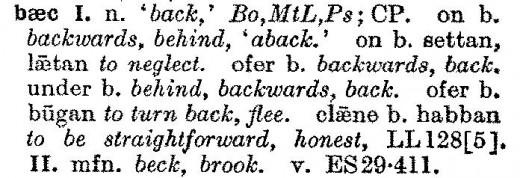
Let's go and have a look at Wisbech, over-there near Ely - the Elysian Fields, as I've described it. Wisbech has a Norman-built castle which, in Tudor days was used as a handy-prison for political prisoners - mostly Catholic priests and bishops, many of-whom died in the dungeons - little-doubt for those poor-souls that this was indeed the entrance to the other-world, and they were sent there whilst still in the flesh, to consider the world-to-come. Robert Catesby and Francis Tresham, after their roles in the Gunpowder Plot to blow-up parliament, were guests.
I don't think I would have liked it there, and I don't suppose any of the inmates did either.
'Bech' is not beach, the way we say it today, even though it was on a beach at one-time, before The Wash was filled-in or reclaimed. I've put a cut from the old dictionary alongside for witness - 'bech' means back, backwards, behind, etc.
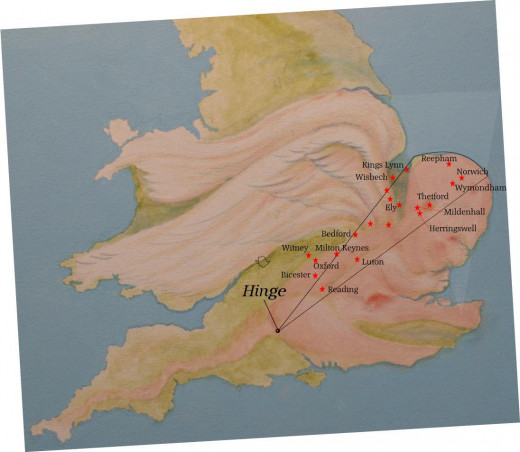
The experts have got their own convoluted explanations for what that means, and reckon it's all to-do with their river Nene being behind or to the back-of the river Ouse. I don't think-so, even if the river Nene IS behind the river Ouse, whatever that's supposed to mean.
No. You can work-out for yourself what Wisbech is behind, at the back-of, I'm reasonably sure by now.
The prefix 'wis' shouldn't be too hard to figure-out either, methinks. 'Wis' is wise, learned and discreet.
Kings Lynn is, as you'll see in a paragraph-or-two, directly on the cusp-line between Gemini and Cancer, when viewed from the other spindle in Canterbury. Kings Lynn was known as Lenne Regis in the time of Henry VIII and Len Episcopi before that. We can dispense with these suffix's but had better have a look at what 'len' meant in the old language.
'Len' means to lend, grant, give and lease. I can only conjecture that this is a reference to Hermes/Mercury and his attributes: protector of shepherds and cowherds, thieves, orators and wit, literature and poets, athletics and sports, weights and measures, invention, and commerce in general.
Hence lending and borrowing are certainly governed by Hermes/Mercury.
When they first started building anything substantial such as churches here, the original settlement was between two rivers, and that's appropriate for reasons I don't have to explain.
The town grew and grew between those rivers called the Millfleet and Purfleet, and they built a port which opens onto the Wash, which in the Middle Ages was very important indeed - second only to London and Southampton for the volume of business conducted here - trade built up meanwhile along the waterways that stretched inland from Lynn, as the locals call the place.
Whilst we're talking about the Wash - the back of our giant's head and the entrance to the Underworld or Elysium - the fisher-folk who trawl the Wash waters have a peculiar saying when they set-out to put to sea. Leaving the tavern-house or kissing the wife goodbye, they say, I'm off now my-dears, I'm going down-below.
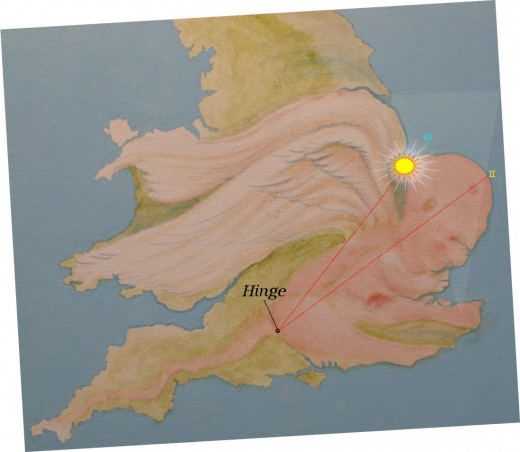
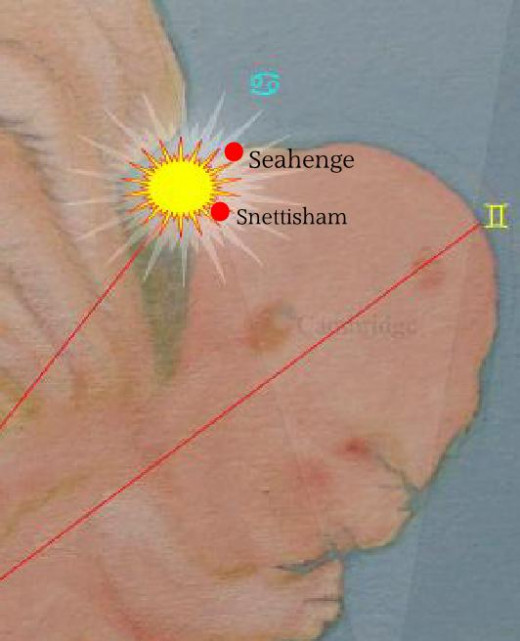
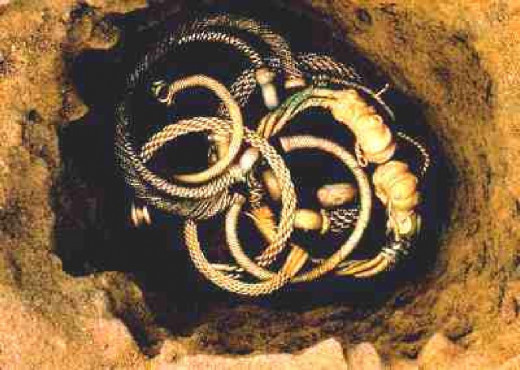
Now then - about the Summer Solstice, which happens when the Sun reaches the end of this sign, and crosses the Tropic of Cancer. As you'll no-doubt know, it is the Sunrise that is the important moment when it comes to this particular solar way-mark.
For the druids who were observing this celestial event at the Hinge of Stone on the Plain of Salisbury, as the mighty-orb of the Sun began its ascent on that morning, it was coming-up out of the Underworld or The Wash, 160 miles distant.
At this moment, they pictured in their minds-eyes, the crown on the crown of a certain giant's head. They knew, like we know, where the Underworld was - inside the head of that giant, in its back-brain.
It's an amazing idea innit? I've done a little picture with the solstice morning event shown, to help with visualising what they more-or-less imagined unaided. Our giant with wings was crowned with the strong-dazzling-rays of the rising Sun, his/her holy-head glowing with a bright-halo of brilliant-light.
Personally, I find it hard to imagine that those druids at the Hinge threw any-kind of party there, at the device itself. That would be a little like having a rave-up in Jodrell Bank's control-room. Not quite right for the occasion, methinks.
No, the rituals would have happened in more appropriate places - dare I suggest that a more appropriate-place might be in that big-old bonce itself? And also that the rituals themselves were very-far removed from what the neo-pagan's of present days imagine them to have been. I don't pretend to know what they did on those three mornings (and probably all day too) of the solar-standstill. I can't help but suggest that it involved heads and brains and blood, metaphorically and actually. And on that note, I have to mention Snettisham (see map) and what the plough-man found buried in a field there in 1948, 1950, 1964, 1968 and 1973 and 1990 - stash-pits of very well crafted torques, coins, and ingots in bars which had been bent to form bracelets. In all there was a total weight of just-over 66 pounds, much of it gold and silver.
A torque or torc is twisted strands of gold, silver or a combination called electrum - worn round the neck which were equivalent in the ancient's world of crowns or coronets. There were 175 in all, 75 more or less complete, and deliberately broken fragments of 100.
Three of the treasure-pits were double pits with two compartments one on top of the other. The top-boxes were all-empty and all of the offerings were in the lower-one. The objects were placed in a very deliberate order - in each case the most precious torque was at the top of the arrangement.
The coins in the hoard were of a type the experts have dated to around 70BC, though no-one's totally certain about that as the ancient coin-minters didn't put the year of manufacture on them, like-wot we do, nor any images.
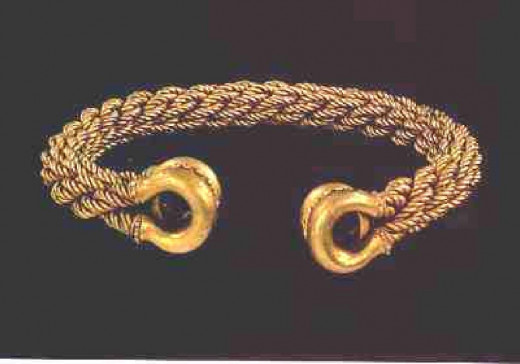
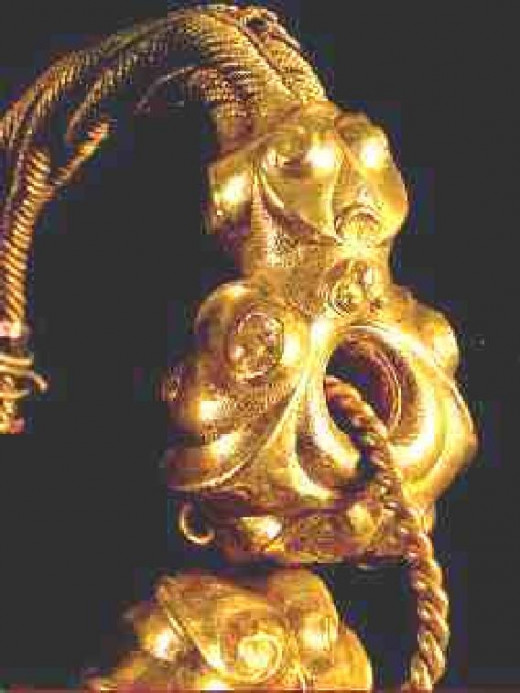
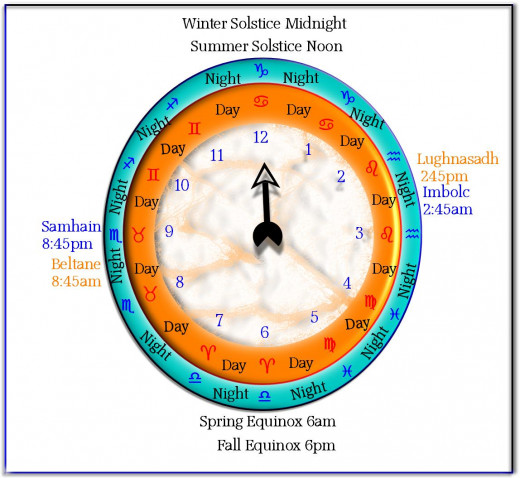
poor Jonny
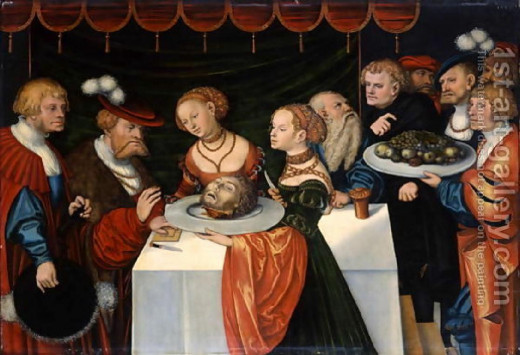
The experts think that the stuff was put in the field for purely practical reasons. They say that the broken-ones were here to be repaired deducing that this area was some-kind of ancient repair shop. As you'll probably have gathered by now, I think they're pretty wide of the-mark about that.
Each of the torques belonged to a chief or head or king of a peoples in the ancient island of Britain. Torques - like crowns - were handed from father or mother to son or daughter in hereditary style, as today, as ever. I say that to break-one was sacrilegious, illegal, forbidden, taboo, unlucky, accursed... to all and everyone apart-from the one or ones that awarded the torque to the lineage in the first-place - the arch-druid, the head of the druid order or priesthood. And I have to say - these broken torques as-well-as the unbroken-ones, were what we would call sacrificed to the one in the land. I believe that the 'one-in-the-land' is depicted on what they call the 'marriage-torc,' the one with the face-on-it in the photo.
In the esoteric and astrological law of similitude and likeness, gold and the Sun and the monarch are of the same ilk. The human-head is the 'king' or 'monarch' of the 'subjects' or physical-body - so gold and monarchs and heads are one-and-the-same, identical, no different.
So, to take the gold of the heads of the land, and place it carefully in the head of the 'god,' is a powerful magik indeed.
Especially as the 'heads' in question willingly gave their own-heads, for that was the only way and reason that a torque could be destroyed.
I'm reasonably certain of this and for several reasons. One of these is, as ever, the place-name itself, Snettisham. 'Snid' and 'snide' are two old Anglo Saxon words that were pronounced identically with the prefix 'snett,' as 'd' and 't' were pretty-well interchangeable letters back then, before the rules-of-grammar were invented.
I say this because 'snid' (snit) means to slice, saw and slaughter,and 'snide' (snit) means incision, slaughter.
Another reason I'm so certain is because of the time-of-year - noon on the cosmic-clock or Summer-Solstice. This is of course, the awful three-day pause at the solar standstill just-before Sol the Sun begins to go-south again, starts to fall to his extinction! He may well-be at the utmost heights of his powers today, shining brightly and hot and unafraid of the serpent of destruction - see how he rose-out of the pit this very morning! He has defeated the serpent again and again and again. He is proud, arrogant, glorious, undefeated. And doomed.
Whatever kind-of celebration the folks engaged in to celebrate the Sun in his strength, was tinged with sadness.
The Christians did a marvellous job at preserving all the important old holy-days by Christianising the symbolism of the pagans and declaring those special days Saints Days. The emblem or sigil the druids were employing back-then is now concealed in plain-sight for us by the saint now remembered on Summer Solstice - it's St John's Day, innit - one of the oldest festivals of the Christian church, first recorded in 506AD. The actual day the Christians mark the rite is on the 24th, but don't let that put you off, they've got a record of interfering with calendars to alter perceptions about the real meaning of the rite.
Well, I say that putting John The Baptist's name on the day is highly significant because of his fate. He was the guy that had his nut lopped-off and presented on a platter to a dancing-girl.
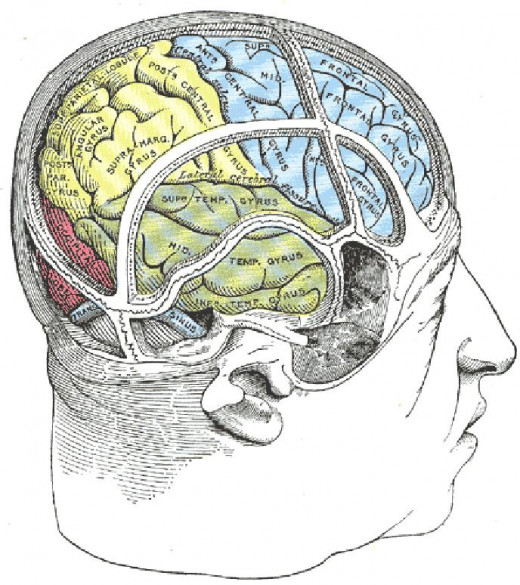
These gold and silver objects belonging to powerful people were in the part of the brain of our landscape-god, known as the occipital lobe. This part of the grey-matter is associated with interpreting visual stimuli and information - receives information from the retinas and interprets it - color discrimination, motion perception and all-that, goes-on in this part of yer 'ead.
It's a rather interesting exercise in musing, to imagine that on these three-days of maximum-light - solstice - that the gold and silver placed-carefully in the giant's occipital lobe of visual-processing is being 'magnetised' or 'energised' by the very-source of vision itself, the Sun.
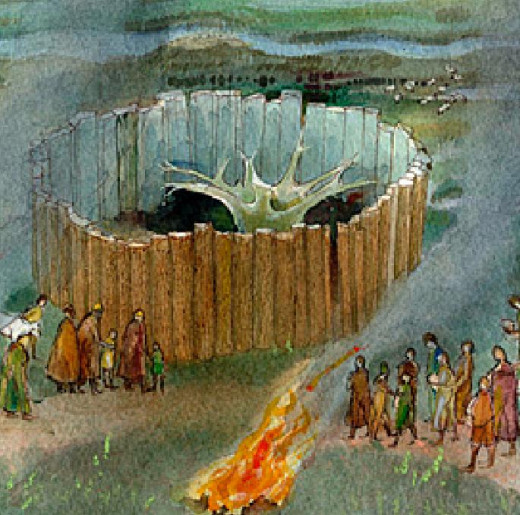
I could dribble-on about that for an age and half-an-age, but we've gotta move-on. There's still a lot of business around here to look-at.
Like that ring-of-oaks up-there on the crown of our giant's head - very erroneously called Seahenge. I call it 'erroneous' because, as you know by now, I repeatedly drone-on about Stonehenge being a hinge in stone on which hang the Sun, Moon and planets. Seahenge on the contrary is NOT a hinge, but something else altogether, as I'm sure you'll be intuiting already.
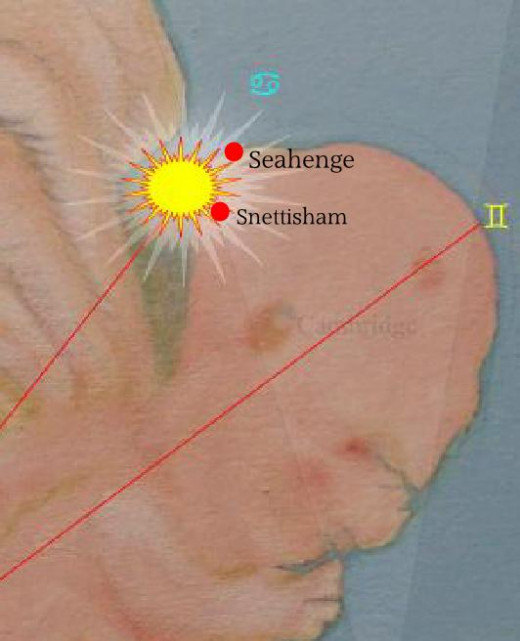
You only have to look at where it's located in relation to both The Hinge and our giant's head. It's at the place on the big-bonce where, on yours and my head, there's a spiral of hair called the crown ('crown' is from Latin 'corona' (wreath). And in relation to The Hinge it marks the place where the Sun rises on Summer Solstice - it's exactly 160 miles from here to the device itself.
I s'pose I'd better mention this too - you'll remember (I hope) that from The Hinge to the underground chalk-cut temple on Thanet it is 140 or seven-score miles - that alignment marks the Equinox and this one, marks the Solstice. Mileages of 140 and 160 - what are the chances of that kind of accuracy over such a distance - coincidence?
From the temple on Thanet to Seahenge is exactly 120 miles. That's multiplications by ten of 12, 14 and 16. And of course, as I've definitely pointed-out before (I'm sure I have), if you connect these three points together you end-up with what I've called the Triangle-of-Light.
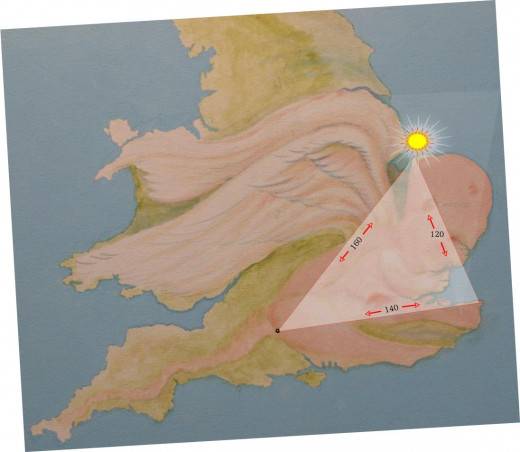
I've called-it that because during the light-half of the year the Sun rises within that triangle - the signs within that zone are Aries, Taurus, Gemini, Cancer, Leo and Virgo. When the Sun exits the triangle at the Autumnal Equinox and goes 'behind' and 'below' the giant, the winter ensues and the world grows dark and cold.
I believe that when the Sun is in the triangle-of-light our giant is polarised male, whilst during the winter when the Sun rises below and behind, then she is polarised female. To be blunt about it, landscape-Hermes' todger gets warmed in the Sun in the summer months, and in the winter it is her female bits receiving the light.
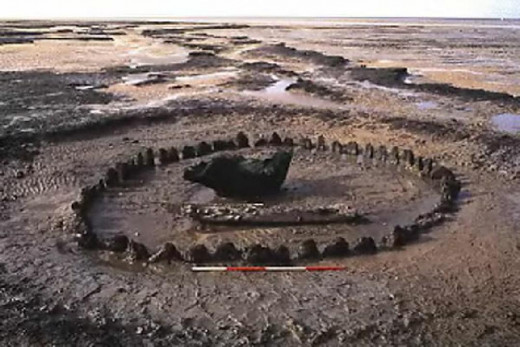
But back to the crown of Hermes' head, and that peculiar ring of oaks our ancient landscape artists put-there. It's a ring of 55 small split oak trunks forming a circle 23 by 20 ft. The timbers were arranged around a trench. Their split sides faced inwards and their bark faced outwards, with one exception that faced inwards. One of the trunks on the south western side had a narrow Y fork in it - facing The Hinge - another post had been placed outside this Y piece, preventing light from entering. The timbers were set in ground to a depth of 3 ft 3 inches - how far they extended upwards can only be guessed at - this was then roofed-over to keep-it-dark in-there. In the centre of the ring was a large oak with its roots upward and its branches buried in the giant's brain.
But that ring-of-oaks was considerably more hassle to install than you might imagine. The central-oak, upturned in the ground (his skull), isn't native to England. They grow here OK nowadays because the climate is mild by comparison with how it was then, 2100 BC to 2001 BC. It was colder then and the type of tree they wanted - a holm-oak - didn't grow here at the time. The nearest available would have been somewhere in the Mediterranean. They had no-problem with the small posts, they were English oak and grew all around - but that evergreen tree at the centre was a different matter altogether. Not only were they aware that such a tree existed, far, far away, but they also had the means to go-there and get one! And when they'd gone all-the-way to the Med' and found their miraculous-evergreen-oak, they then went to all the bother of up-rooting it from its native-soil without harming the tree, and then somehow-or-other transported it all the way back to the shore of The Wash, dug a ruddy-great hole and planted it upside-down.
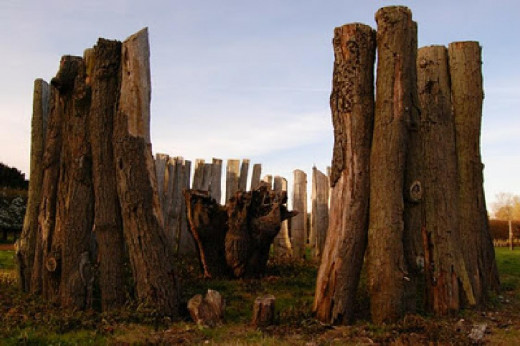

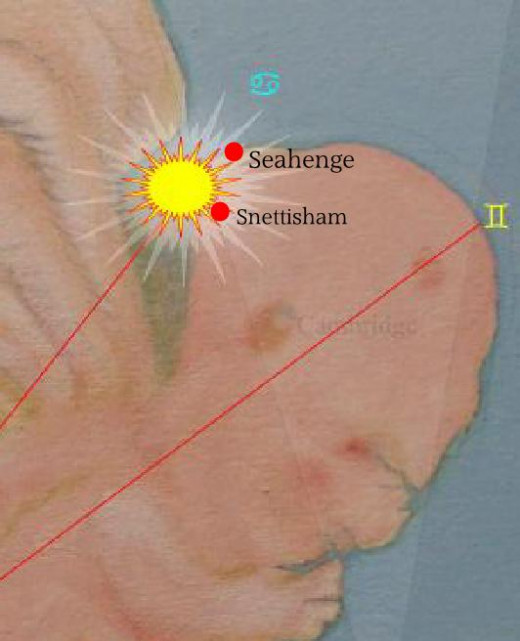
When the archaeologists were busy uprooting-it they found what they-called 'ropes' of yew-withies twisted and plaited around the remaining-stump - but these weren't ropes, were they? Of course they weren't - they wouldn't have inadvertently left their ropes wrapped around the precious thing. No..... these plaits and ropes were representations of hair spiralling around the crown. It's an amazing art-object, a sacred machine-part.
And so.... at the other-end of the year, at Midwinter solar standstill Sunset, the priests would remove that post that blocked the light and allow the dying rays of the year's light to enter the enclosure and alight on the roots of the tree.
Is this not incredible?
It's not for me to tell-you what to make of-it-all, and what to imagine our ancient's were thinking, and imagining, but it is for me to point-out the distinctly Geminian aspects involved in the symbolism.
Gemini is the sign of polarities, the north (geographic) pole and the south (geographic) pole, the twins, the opposites.
The inverted-tree encapsulates the idea in one symbol. It is involved in both the Summer-Solstice AND the Winter-Solstice. The evergreen tree is a symbol of immortality and eternity, yet here it acts as timekeeper of the seasons in this temporal-world of birth and death. The evergreen reminds the mortal-twin of the existence of the immortal-twin. It's roots are anchored here in the world of the living and dying, the world of man. It's branches open into the Underworld, the Elysian-Fields where dwell those who've passed beyond this veil-of-tears and now dwell in eternity.
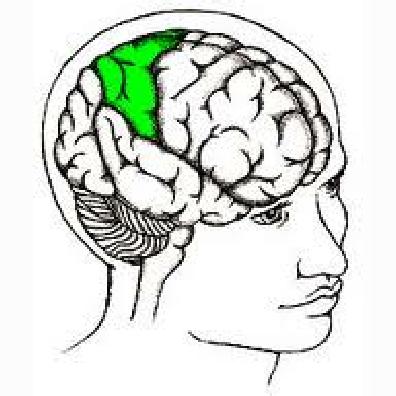
Where this corona (wreath) of evergreen is located corresponds, in the brain, to the parietal-lobes, important in integrating sensory information from various parts of the body, knowledge of numbers and their relations, and in the manipulation of objects. It receives somato-sensory and/or visual input, which then, through motor signals, controls movement of the arm, hand and eye movements. These are the very organs and functions traditionally governed by Mercury.
For the moment that concludes our investigation of the alignments from The Hinge during the month when the Sun rises in the sign Gemini. As I always say, there's thousands and thousands more to look-at but there are limits - I've only got a month to get these articles written and drawn and that's getting to be not enough time.
So on we go - but we'll definitely be coming-back this way, 'cos as you can tell from my pictures and wot-not, the Gemini alignment and cone of influence as viewed from the ankle in Canterbury, goes straight to the same region - this big head.
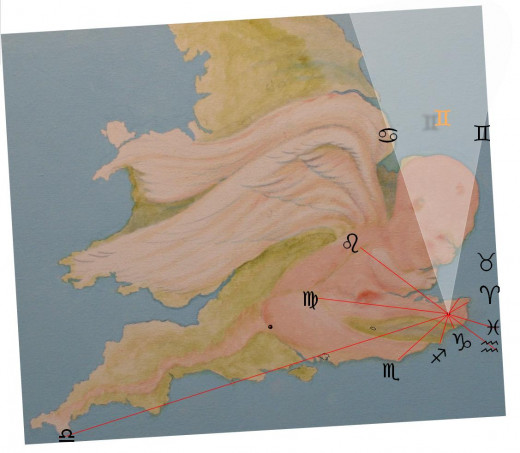
The loving, emotional-self has often been compared to warmth or heat, while the intelligence and calculating intellect get labelled as cold, even icy. That's why, before we take a detailed-look at the Canterbury alignment I thought I'd show you where this sign of the cold, calculating intellect globally-illuminates with its cold-beam.
Look at that would-ya..... Northern Siberia and Greenland, up through the Arctic-Circle and including, in its encompassment, the North-Pole.
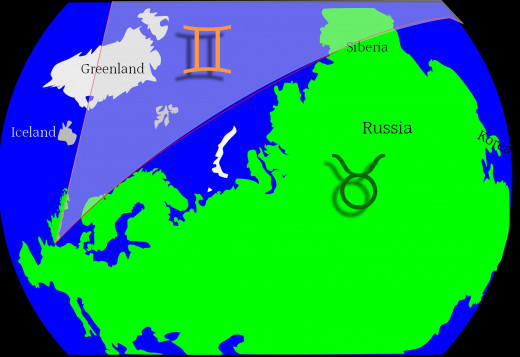
But, we’ll go-about this as we usually go-about-it - that is - we’ll start this leg (pun) of the investigation at Canterbury, in the ankle-joint of our big-bewinged-baby, and move-out from that centre into the local environ’s of North Kent and then we’ll go back up-there into that head-space again, as that’s where this alignment heads-off to.
So, on the local-level then, we start our journey once-again at St Augustine’s Abbey, in the heart of English-Christendom, Canterbury.
As is always the-case, near to Canterbury the landscape is so jammed with place-names and places that I hardly-know where to start...... umm, I s’pose we might as-well start at what is known locally as the ‘poets-estate,’ on the outskirts of the city. A housing-estate where most of the streets and blocks are named after famous wordsmiths..... driving there from St A’s we go along a recently-cut link-road named after the author of Rupert the Bear, Tourtel Drive, it’s called. On the estate itself there’s Tennyson Avenue, Shelley Ave', Dickens Ave', Eliot Close, Field Close, Reed Avenue, Forrester Ave' and Conrad Ave'. What are the chances of that being a coincidence?
On the other-side of the main Sturry Road, there's a pub by the name of the Vauxhall Tavern - it’s called that because it serves the Vauxhall Road Trading Estate.
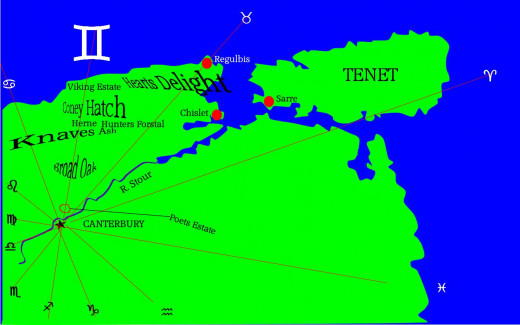
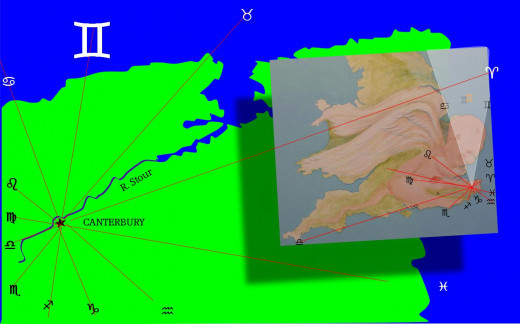

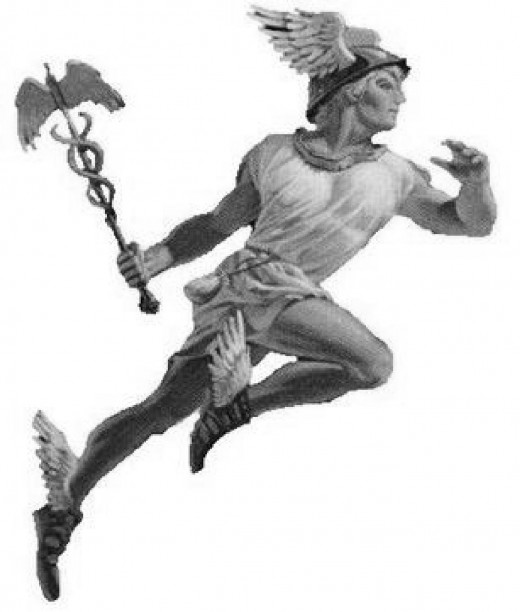
You’ll remember that the Gemini alignment from The Hinge includes Luton and Bedford, and that we noted that motor-cars and vans have made their presence known there.
Here in Canterbury’s Gemini cone not only do we find Vauxhall’s mentioned in these place-names, we also find vehicles here too - in plenty.
Virtually every car dealer in the world has a showroom on the Vauxhall Estate, as do motorcycle manufacturers. I’m not here to flog-cars for anyone so I’ll refrain from name-checking them. All I can tell-you is that vehicles have, for as long as this estate’s been here, been displayed and sold on the Vaxhall Estate.
To demonstrate that coincidence plays no-part in any of this, lets nip-along the road, through Herne Village and into Herne Bay. When we get to the coast we’ll turn-left and come-out of the town heading towards Whitstable, and just-before Stud Hill on the bendy-road there’s a small housing-estate called the Viking Estate. I've stuck a Google Maps gadget alongside so you can verify that I'm not seeing-things, 'nor telling porkies.
We've come-here to look-at the street-names, for reasons that will soon be clear enough: Morris Ave, Austin Ave, Riley Ave, Daytona Way, Alvis Ave, Ford Close, Wolseley Ave, Hillman Ave, Chrysler Ave, Bentley Ave, Talbot Ave, Daimler Ave and Vauxhall Avenue.
Crazy innit? Nothing is random, - so-called ‘coincidence’ reveals the hidden patterns - and here that pattern is - as you know - Gemini and local-travel, amongst other things.
Now, I’ve mentioned this fella before, in the Aries article. He was in that article because he was interred on the island called Thanet.. I’m speaking of Dante Rossetti, one of the three-founders of the Pre-Raphaelite painting movement. He named himself after the reformation poet Dante Aligheri (wrote the Divine Comedy) because he believed himself to be the reincarnation of him.
Anyroad, he’s in this article because he lived within this Gemini sector in a farmhouse-retreat in the village of Hunters Forstal, but a stone’s-throw from Herne Village.
Well... this dude was THE Mercurial, Hermetic inspired poet, if ever there was one. His painting style and technique raised mere-mortals into god-like beings - that was what the Pre-Raphaelite’s were all-about - and realism was, to Rossetti and cohorts, anathema. He would have none-of-it. He was a visionary and a mystic, experimented with hallucinogens - and was great-friends with Lewis Carroll, author of Alice in Wonderland.
It has been said that the Mad Hatter was actually based-on Rossetti, and there are good-reasons to think that that’s quite-likely true. Y’see... he kept a couple of pet wombats and, it was reported, they would sit-on (not ‘at’) the dining-table at meals, much to the amusement of guests - Carroll among them on his occasional trips over from the US.
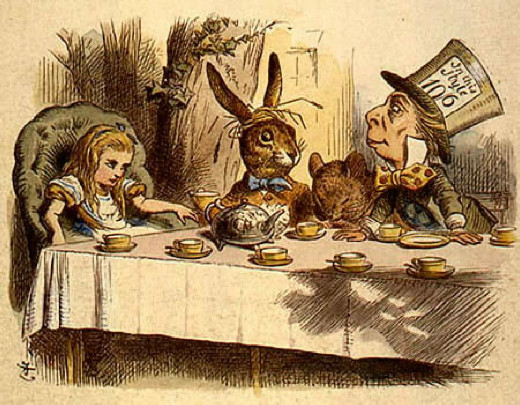
I have to tell you - the fields that lie around Rossetti’s farmhouse-retreat are - from my own experience - laden with magic-mushrooms in October most-years. I can see them wandering-about in the green-pastures talking of literary and spiritual, artistic things.... chewing mushrooms as they went.. Caroll, an American, would have been knocked-out by our English countryside and - more to the point - our fairy-tale like place-names. I think that THEY are responsible for those characters in his book! I mean, just look-at some of them:
There’s Frog Island (farm), Knaves Ash, Broad Oak, Maypole, Owls Hatch Road, Heart in Hand, Hearts Delight, Coney Hatch (‘coney’ is Old-English for rabbit), Old Tree, Maytree, Babs Oak.... I’m sure there’s many more but you get the gist? Knaves & hearts & rabbits & hatches (a ‘hatch’ is a hole in a wall, through which things are passed), and an island of frogs.....
I’m sure that you’ll remember in the Taurus article, the stuff I wrote about the bull in the Wansum and the Stour? And the place-names located at the bulls-throat and neck - Sarre, Chislet and Gore and the interpretation I put-on that? Y’know, cutting the sacred-bull’s throat and sawing its head-off.... I can’t help but think that Rossetti pointed these-things in the Kent landscape out to Caroll, giving him the idea that the Queen of Hearts should repeatedly utter the words: ‘off with his head! off with his head!’
Perhaps I’ve got too-much Mercury going-on in my-own mind - maybe I’ve got it all wrong..... I’m seeing-things again.
You’ll also remember from the same article, I’m equally sure, how I see echoes of that famous outlaw and his seven-score band of merry-men in various place-names around here - Robin Hood, that-is - Beggars Corner, Hoaden, Hoads Wood and others.
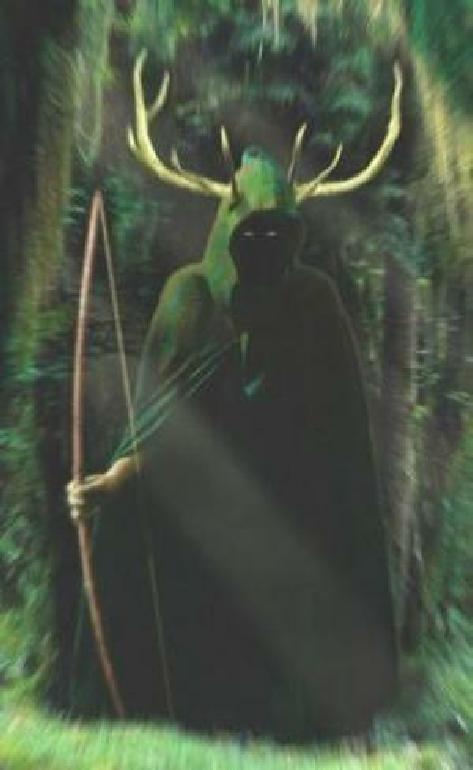
Where Rossetti lived, at Hunters Forstal, close-to the village of Herne, there was once an ancient forest long-ago felled for agriculture. We know this to be true as ‘forstal’ means forestal, Hunters Forstal means Hunter’s Forest.
The beautiful, ancient village of Herne is so-close - and ‘Herne’ was the name of an Old English woodland ‘god’- we simply have to connect the dots and the places and the names..... and we get Herne the Hunter’s Forest.
In English mythology and folk-lore, Herne the Hunter was the name of the guardian of the forest and the forest-folk - he gave Robin Hood protection from the law - Herne the Hunter seems to have had a character and role similar to the wizard Merlin.
I think his name has been garbled and re-garbled, Chinese-whispered down-through the centuries. We used-to call this woodland spirit Herme with an ‘m,’ and that name got slightly altered into Herne with an ‘n.’
Thus Hermes the protector of thieves got warped-into Herne the Hunter - protector of the ‘king-of-thieves,’ Robin Hood. I’m saying, in my dumb-ass way, that Hermes and Herne are one-and-the-same.
The Christians had to find ways and means to get-rid-of this ancient, old god of the English. The God-fearing priests preached that the kindly, wise Herne was none-other than the Devil himself - soon, the mere mention of his name would fill folks with dread and fear and Herne/Hermes became shunned by all good Christians. To propitiate Herne would cause more-bother than you could shake-a-stick-at.
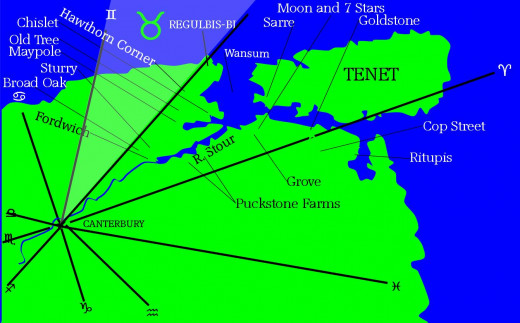
Moon & Seven Stars
Shakespeare's Falstaff, in one of three plays he appears in, remarked,
Indeed you come near me now, ... for we that take purses go by the moon and the seven stars, and not by Phoebus,... Let us be ‘Diana's foresters', ‘gentlemen of the shade', ‘minions of the moon', and let men say we be men of good government, being governed, as the sea is, by our noble and chaste mistress the moon, under whose countenance we steal.”
But - there are still accounts in existence describing the devilish activities of Herne The Hunter, in a woodland somewhere near you - he is mentioned in The Wives of Windsor by that Shakespeare bloke. That’s why the Hunter’s Forest exists in name-only today - they cut-down the trees and the groves. and drove Herne away - they thought.
Ha ha! You can’t drive the landscape away, can you? Nor the spirit whom dwells within it.
The Peterborough Chronicle of 1127:
Then soon thereafter many men saw and heard many hunters hunting. The hunters were black and large and loathly, and their hounds all black and broad-eyed and loathly, and they rode on black horses and black bucks. This was seen in the same way in the town Burch and in all the woods from that town to Stanford, and the monks heard the horns blowing, that they blew at night. Trustworthy men who watched at night said that they thought that there might lit well have been about twenty or thirty horn-blowers. This was seen and heard from when they came thither all that Lenten-tide to Easter. This was its incoming; of its out-going we can not yet say. God fore see.
C.W. Whistler imforms us that a man
dared to cross the path in the dark, and was overtaken by the Wild Hunt as it passed overhead. And when he looked up, there was the devil himself following the hounds and riding on a great pig. What was worse, the devil pulled up and spoke to him. 'Good fellow,' he called, 'how ambles my sow?' The man was most terrible feared, but he knew that he must make some answer, so he replied, 'Eh, by the Lord, her ambles well enough!' And that saved him, for the devil could not abide the name of the Lord, so that he and his dogs vanished in a flash of fire!"
Local Traditions of the Quantocks" (Folklore XIX, 1908. p42) C.W. Whistler.
H.A. Guerber 1922:
The object of this phantom hunt varied greatly, and was either [that of] a visionary boar or wild horse, white-breasted maidens who were caught and borne away bound only once in seven years, or the wood nymphs, called Moss Maidens.
Now, you may be wondering why this is so especially tuned to the wavelength of Gemini and Mercury? Well, it’s all-to-do - I guess - with sanity and insanity - fluffy-animals that fly through the sky - tales which were beyond-belief yet were thought true at the time. It's about superstition. It's about the 'spirit-world' communing with this world - the heavenly-twin and the earthly-twin.
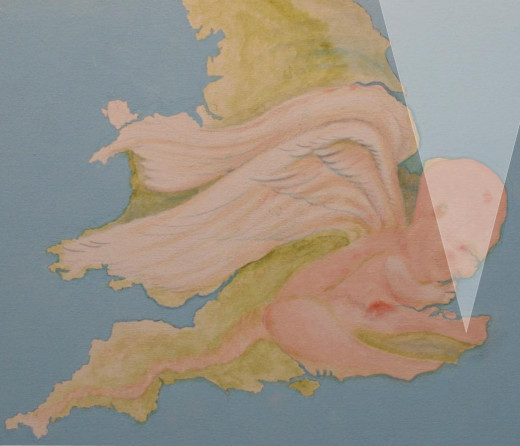
There is a lot-more to see in this small area between Canterbury and the coast but time is always of the essence - we’re ‘heading’ back across the Thames Estuary and into that big-nut again.
At a glance you can see that from this wheel in baby’s ankle the influence of the twins goes straight to where that influence should go - the nostrils, eyes, ears, frontal-lobes of the brain - it even touches the tip of our cherub’s fingers and hands.
And that’s all most appropriate - as is the topography and toponymy, as you’ll see. I’ve drawn a little map of the coastline where the influence first meets Anglia - head-on, we might-say.
My purpose here is not to tell you all there is to know about this giant within whom we all live. I mean, I’d really like-it if you’d buy the book wot I dun ‘cos it’s all in there (available @Amazon.com). The purpose of these articles is to explain about the cosmic correspondencies inherent in the British Landscape and clear-as-day to the ancestors. But I do have to relate some stuff about this giant because its presence backs-up - embodies - the cosmic/zodiacal, intellectual and physiological principles we’re discussing.
Which I think is bloody amazing - and I have to say-it again, I don’t know where to begin.
I’ve deliberately selected a bare-minimum of locations to look-at ‘cos there’s a lot of it up-here.
I've put a rectangle on baby's face to indicate where we're zooming-in on - we're looking-at the eye and forehead of the big-fella, the fore-brain where conscious thinking and reasoning goes on.
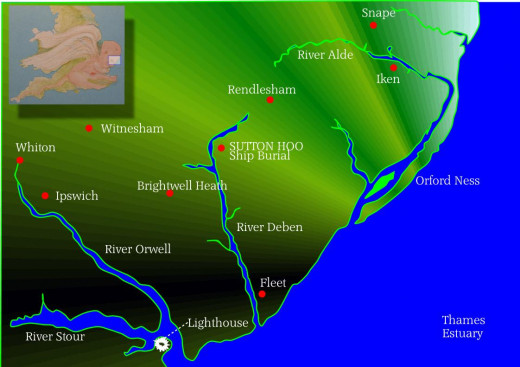
So, how about Orford and Orford Ness then? Well, I mean, you can’t get much-more forward than your forehead, can ya? To my mind, All Forward and All Forwardness is the true intent of the place-names. The ‘Ness’ of Orfordness - that long ‘spit’ of land - was created by the River Alde as it flowed south to the sea past the town called Iken. Given that in Anglo Saxon there was no letter ‘k,’ ‘Iken’ was first rendered ‘Icen.’ But it means the same thing. ‘Ic’ was how they wrote I, me - it’s a reference to self. But anyway, it’s present spelling makes a statement about consciousness, awareness - I Ken - that is - I know, I understand.
The name of the river - Alde - means old, in one sense. In another sense, ‘Al’ is just another-way the ancients wrote El, the most frequently used name-of-God in the Hebrew version of the Bible - and name-checked previously in the back-of-the-head at Ely. Lastly, ‘al’ is an Anglo Saxon word that meant fire and awl, a piercing tool and also all; everything.
Is that appropriate for the intellect or what! - it’s like fire and a piercing-tool, and can encompass everything.
So you see - no matter how you put-it together - when you look-at the whole, big-picture in-the-round, it’s clear-as-air that East Anglia’s place-names spell-out words and phrases that can only be referring to intellectual, mental capacities and abilities..
There are some pretty-weird features not to be found on yer average human-being too - but that’s to be expected, when dealing with the physiology and psychology of immortals.
That spit of land itself - Orford Ness -has really captured my imagination as it surely captured the imagination of the ancient-ones, the circle-builders. Long strands of earth like Orford are called ‘spits’ because they resemble snakes. So here’s a snake-like feature in the landscape that just-happens to be protruding-from the forehead of a ‘god.’ Ummm.... I don’t suppose you’ll really need any help with this, but I’ll put an image in anyway.
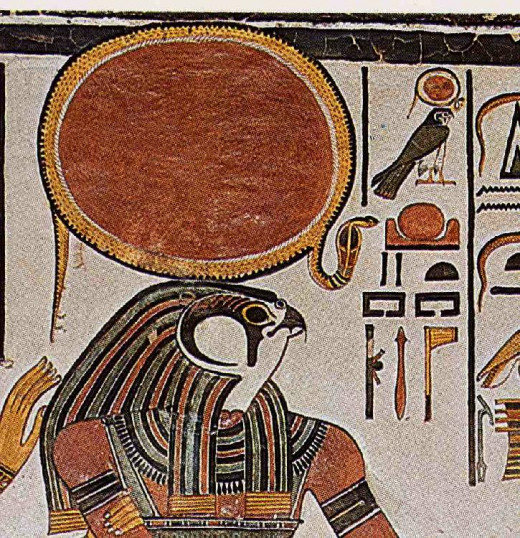
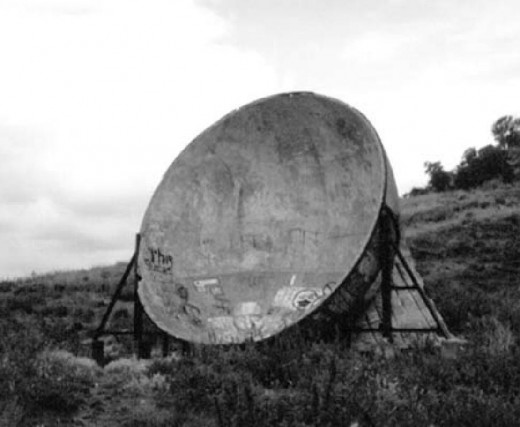
Cobra Mist Array
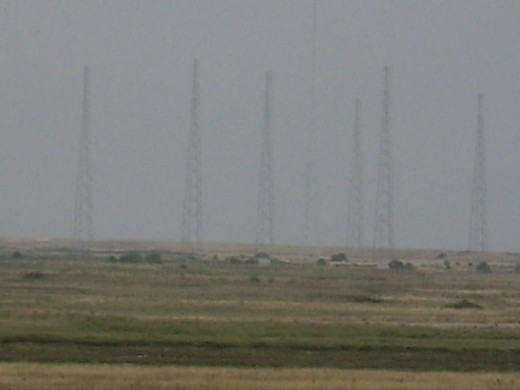
Before the invention of Radar the boffins were experimenting with 'sound-mirrors,' listening-ears that were designed to focus-on and amplify the distant hum of aircraft-engines, giving - it was hoped - an early-warning of invasion and bombing-raids from the air.
They decided that the spit of Orford was perfect for their needs, and built a number of experimental devices here (see pic). Hmm... seeing-without-eyes or seeing the invisible - on a serpentine-spit on the forehead of a giant..... it seems - to me - that a more-appropriate location than this can't possibly exist, anywhere in the world. It tickles my fancy.
Then some egg-head cracked-it and Radar took-over from the mirrors before they were ever put into service.
After the war, the yanks took-over the facility and conducted some weird-shit of their own. They covered the spit with radio-antennas and started using the huge-array to bounce very-strong radio-signals off of the ionosphere, over the horizon into Russian and Chinese radio-space, and ‘over-hear’ their military communications. They say it didn’t work and eventually abandoned their attempts to ‘hear the invisible’ - to ‘see-round-corners,’ to ‘know the minds’ of their foes.
But the thing that puts the cherry-on-the-top of all-that, is the name of the American attempt on the Orford spit - Operation Cobra Mist.
I often wonder who knows what.
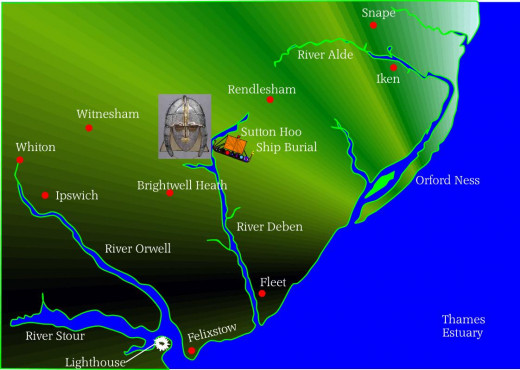
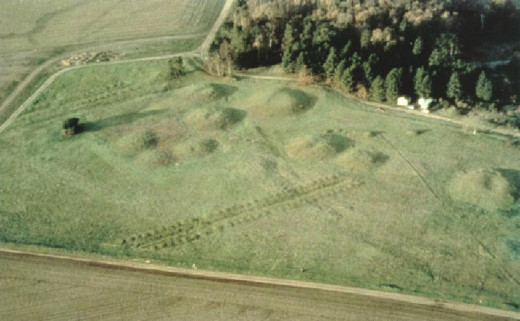
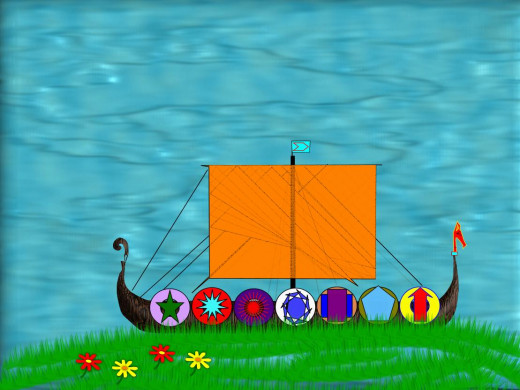
As you can see from the map, roughly seven miles to the west, on a rise over-looking the River Deben, is Sutton Hoo and its utterly incredible ship-burials.
In a ship sort-of similar to the one I’ve drawn, a man was laid on his couch dressed in the finest metalwork-suit, surrounded by his best possessions - including his horse - on a journey from which they have never-yet-returned.
Accompanied by a small-fleet of similar-ships - they were frozen-in-a-moment-in-time. And then sometime in the 6th or 7th century - to protect the fleet from the Christian wreckers no doubt - the ships and their occupants were permanently hidden-from-view - buried beneath mounds of earth, to continue their travels in their ships-of-dreams, unto eternity..... in the forehead, the minds-eye of a god.
As the motor-car is the current means of travel around the environment - and we’ve seen plenty of those in the Gemini zone - horses and ships were the means back-then in the olden-days. Far-off lands were first dreamed-of, imagined, seen in the minds-eye, located by the inner-radar, before they were made-real on the horse or in a ship.
Horses and ships therefore are associated with the imagination and dreams - night-mares and new horizons
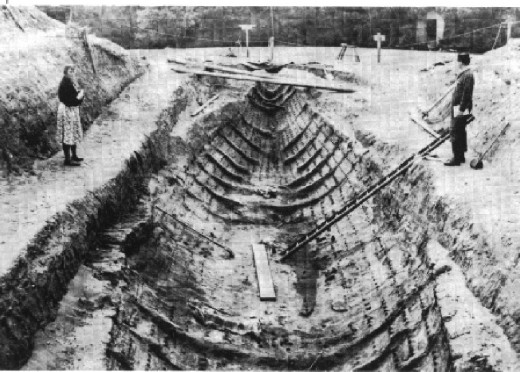
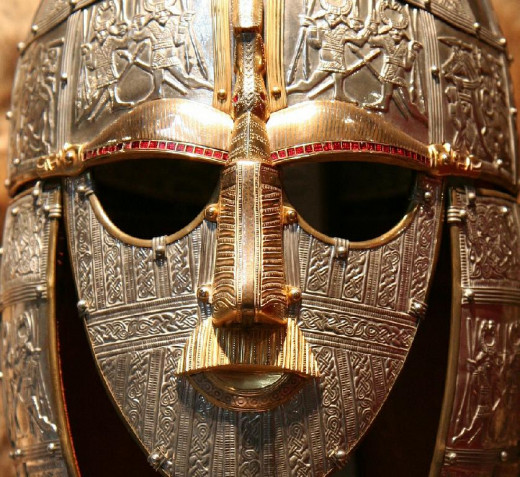
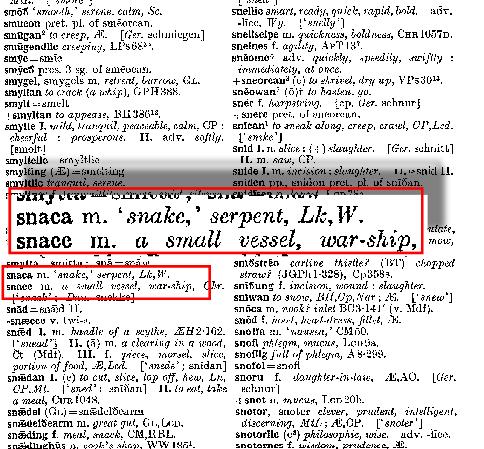
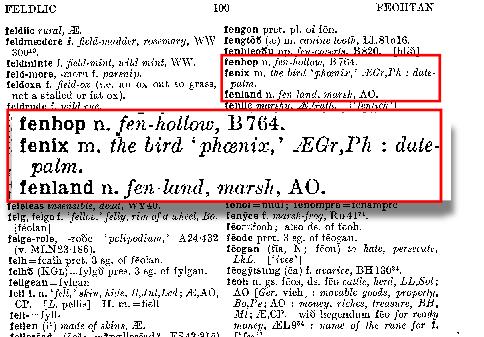
I have to tell you this too: serpents and snakes and ships also had an affinity in the minds of the ancients. The Anglo Saxon word for a small war-ship - like the ones at Sutton Hoo - was ‘snacc,’ and that also means snake/serpent. And so, seven-miles away is the big-snake of Orford - given the sacred connotations of the number 7 and snakes, I have little choice but to deduce these locations are very definitely related.
The ‘captain’ of the ship was wearing a face-mask that reveals his identity as a high-king or lord over the region depicted (in code symbols) on the mask itself. But you have to know that there’s a code there in the first-place - and the experts have no-idea that there IS one.
I know or think-I-know that the face on the mask is a codified-map of the land, because the design on the face contains all the elements we’ve been looking-at in the Anglian landscape. - which you and I know is also a head and face, but the experts do not.
But that doesn’t matter anyway - the sheer finery of the burial told the experts that this MUST be a king, so it didn’t really matter that they couldn’t read the map on the mask.
On the mask the actual location of the ship-burial itself - and the occupants - is pointed-out. It’s above and between the eyebrows, which are the wings of a bird - in the gap where the birds (phoenixes) meet at their beaks. - THAT is Sutton Hoo’s snacc, and Orford’s spit.
The reason I say it’s a phoenix-bird’s wings that form the eyebrows is because of the presence of the eyebrow town of Felixstow (see map). Though the experts say that the town is named after St Felix I disagree heartily. I say that it was originally called Fenixstow - just one letter’s difference. ‘Fenix’ was the Anglo Saxon spelling of phoenix - the fire-bird that symbolises death, resurrection and immortality. You’ll note that Phoenixstowe is located on the opposite bank to a former lighthouse, in what can only-be-described as the eyelids. The waters that surround the eye-ball itself are called the rivers Stour and Orwell.
Coincidentally (not), the helmet is covered in pairs of warriors (twins), with serpent-head horns....
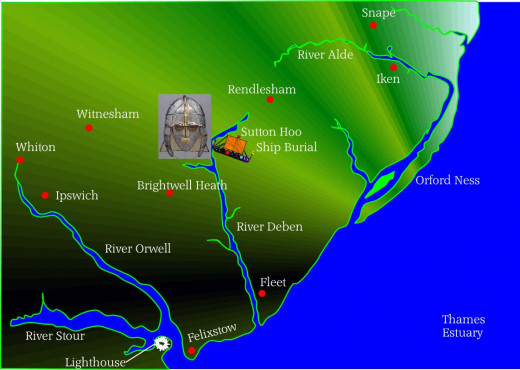
The Twins
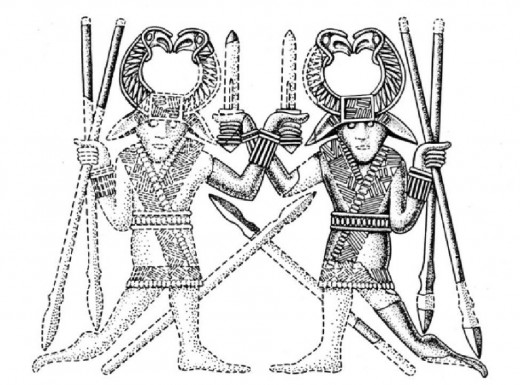
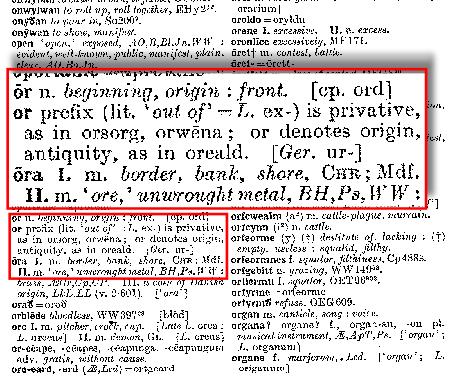
The paired and crossed swords and spears represent how the opposite-polarities of Gemini work-against each-other and yet, paradoxically, with each-other. The opposing of the blades is converted into useful action by cutting through something producing progress forward - a pair-of scissors for example. A ship, to go further with the example, cuts-through the fabric of the waves, producing motion and travel to opposite-shores.
The twins that we call the eyes are - of course - all-about light and dark, yin and yang, open, close, up, down, left, right. We have stereoscopic vision that feed information into a stereoscopic brain and nervous-system.
Back-there in Kent, the river that flows through Canterbury is called - if you recall - the River Stour. This one here has the exact same meanings as that one there - only now, here in the eyes, it makes even-more sense. ‘Stour’ means star and steer.
Wow, is this the origin of that saying stars in your eyes? No matter - stars and steering are all about eyes, travelling, direction, going-about visiting places and people - pure Gemini.
The other river, the Orwell has an equally profound significance. 'Or' the prefix means to the front, the beginning, the origin.
And because we're in the eyes of a landscape-god, beginning and origin makes me think of light, and Genesis....
1:1 - In the beginning God created the heaven and the earth.1:2 - And the earth was without form, and void; and darkness was upon the face of the deep. And the Spirit of God moved upon the face of the waters.1:3 - And God said, Let there be light: and there was light.1:4 - And God saw the light, and it was good: and God divided the light from the darkness.
'Wel,' the suffix isn't only a deep-hole in the ground containing a bucket on-a-rope and water. I've stuck excerpts from the Anglo Saxon dictionary in hereabouts to show that it totally relates to the above passage. 'Wel' is happiness, riches, abundantly, very-easily, fully, indeed, to-be-sure.... to create the universe, all it took was a few words - a spell - and spelling of words is governed by Gemini.
On the matter of gods.....
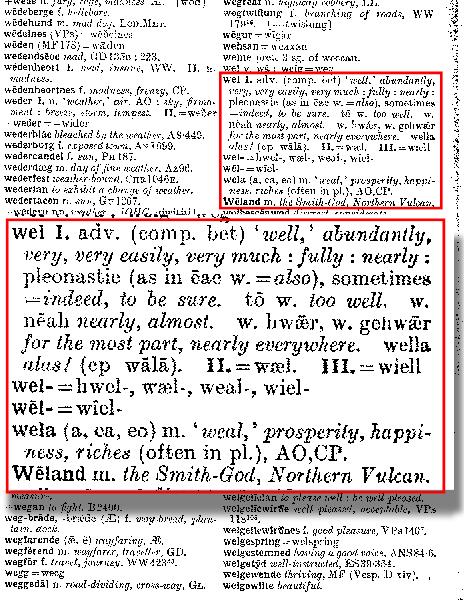
In the Anglo Saxon dictionary (inset), beneath the listing of 'wel' and 'wela,' is 'weland.' Weland was one of the names of the smith-god, also called Vulcan. He had two brothers, and the three of-them were the boyfriends of - and lived with - three of the Valkyries. Everything was fine and dandy and then, nine years later, two of the Valkyries left his two brothers - which drove them out-of-their-minds so they followed the gals, never to return. I thought I'd better mention Weland/Vulcan because of the lost-brothers motif - it's central to the telling and meaning of his tale and pure Gemini.
Another totally Geminian thing about Vulcan/Weland, is that he lends his name to the welding-process - vulcanisation - where two distinct, separate halves of a material are melded together into one, whole fabric. Gemini's tarot-card is The Lovers......
Up-river a little way inland is the big-town of Ipswich - formerly writ as Gippeswicke, a name taken from the River Gipping which is the non-tidal part of the Orwell. Earth ramparts encircle the town which - it is assumed by the experts - were defensive in nature. Possibly that's true, but I happen to think (I can't help it) that earth-built circular-things here, in the eyes of a god, were 'installed' to remind the folks where they were.
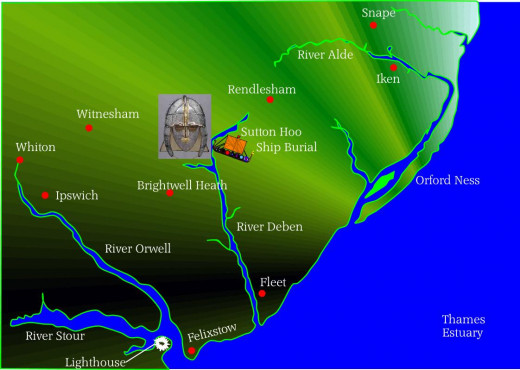
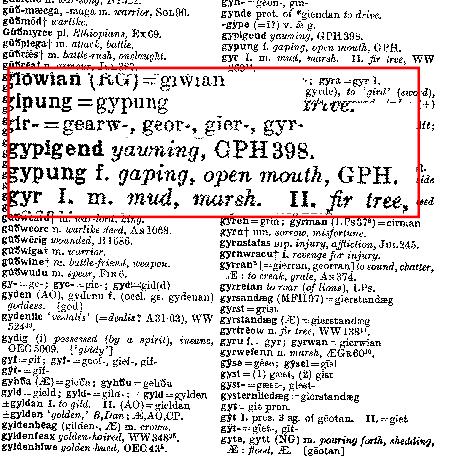
Gippeswicke was an important place in the olden-days and they even minted their own coins - the abbreviation 'Gipes' appears on them - I believe the locals referred to the place in that way - gapes.
I'll put another cut from the dictionary in to show-you I'm telling the truth about this. 'Gipes' and 'Gipping' mean gapes and gaping. Ho ho ho... how this must have confused the hell outa the experts. I can hear their brains whirring - why the crap did they name a town and river that??? Were our ancestors crazy???
I DO feel a certain sympathy for them, these place-names blew-my-mind too - they forced me to recognise first the zodiacal, and then the humanoidal nature of the British landscape. It took years to work all-this-out. But it forced our experts to invent countless numbers of powerful chieftains and leaders who named the places - villages, rivers and towns after themselves - 'cos they were - in the expert's imagined scheme-of-things - all egomaniacs, those ancients.
But here they realised it was the river and never bothered with a chieftain - they didn't, however, enquire as to the reason the river was named as such - the gaping. To you and me it's perfectly obvious - gape is what eyes do, innit - but we're in a better position than the experts were. We know about the big-baby with wings and a tail, we know Ipswich is in the eyes of that baby.
Whitton (mis-spelt on my map) is right up-there near the source of the river. It was in the Domesday as Widituna, and that means wide. 'Tuna' is 'ton,' enclosure, garden
So on the river Orwell we have two places whose names, taken-together, say the words gaping-wide.
Behind your eyes but in-front of your ears is what is called the temple - when we indicate that we think someone's not right in the head the temple is the place to where we point our finger and rotate it. In our landscape this corresponds to the town of Witnesham and the area of Brightwell Heath. Witnesham was in the Domesday book as 'Wytenesham.’
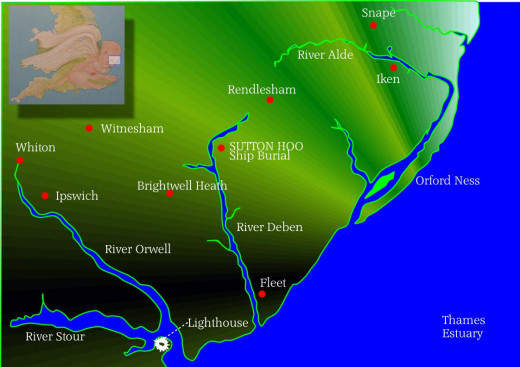
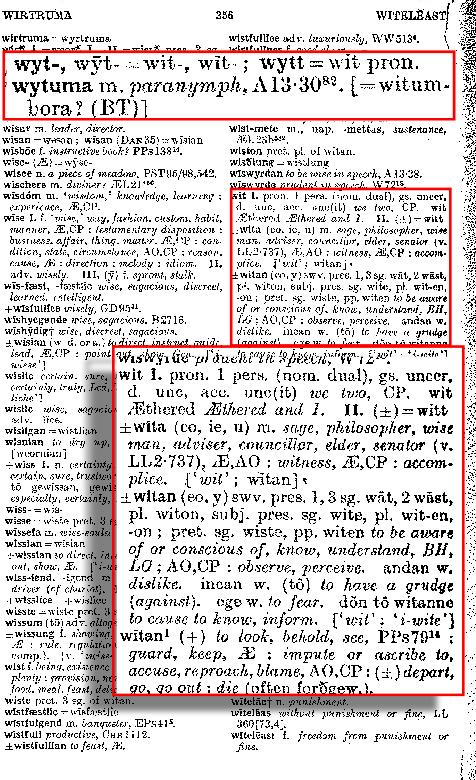
Gemini
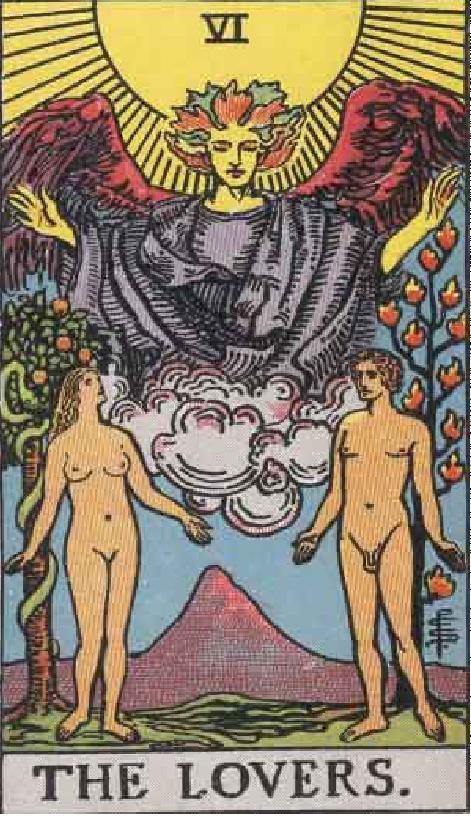
As you can see from the dictionary - when I looked-up 'wyt' I was directed to go see 'wit.' But before I did that I noticed that one of the related words 'wytuma' had the meaning given as paranymph. I had absolutely no-idea of that word's meaning, so went and looked it-up on Wikipedia - I've copied and pasted the paragraphs from there:
A paranymph is a ceremonial assistant in a ceremony. In ancient Greek weddings the bride and bridegroom were attended by paranymphs, and from this use it has been generalized to refer to attendants of doctoral students, best men and bridesmaids in weddings and the like. It can refer specifically to the friend of a bridegroom tasked with accompanying him in a chariot to fetch the bride home.
..... and also: The word may refer also to a thought that is revealed only by a slip of the tongue, such as a Freudian Slip, or a condition where such slippage is endemic.
So... here, in the big-head's temple (the Temporal Lobe) is a town whose name's interpretation could certainly be read as a ceremonial assistant in a marriage AND as a slip-of-the-tongue - somewhat Geminian, it has to be said. Just to drive-home the point I've pasted the Geminian tarot-card hereby.
The temporal lobe is involved in auditory perception. It is also important for the processing of semantics in both speech and vision and plays a key role in the formation of long-term-memory.
So, the place-name Witnesham - witness'm as it's pronounced, far from being, as the experts propose, the field belonging (to some unknown chieftain called....) Witta, it is a very-clever, very subtle spell (for want of a better word).
Going back then, to the dictionary's redirection of attention from 'wyt' to 'wit,' as it is today spelled in Witnesham, we see that 'wit' means - unexpectedly - we two. What are the chances of that, eh? We two needs no explanatory comment from me, I'm sure.
'Wit,' 'wita' and 'witan' also have the meanings - as we've seen earlier - of sage, philosopher, wise man; witness, accomplice, and to look, behold, see, and ascribe or impute to and to know, to cause to know.
If I add anything to this I'll be over-egging the pudding - the meaning of the place-name spells-it-out as clear as day. It also tells me that the ancient folk (whoever they were) knew perfectly-well exactly where all this cognition and seeing and thinking was actually carried-on. They didn't seem-to believe that consciousness and cognition went-on in their stomachs, for example. There is an old-saying about Suffolk that sort-of suggests that the county has traditionally been known for some connection with consciousness - the county was known as Silly Suffolk, which has baffled historians and antiquarians for some time. Silliness - of course - is an aspect of consciousness, mentality.
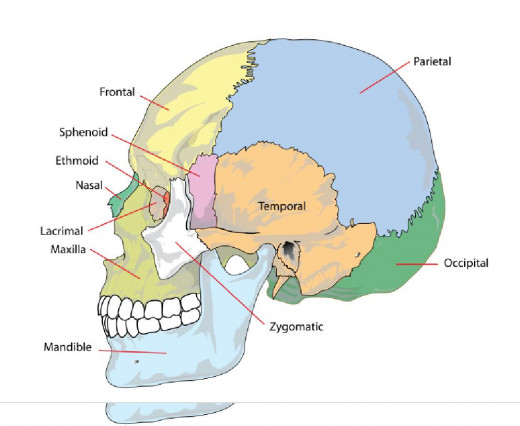
Though you won't find Brightwell Heath on many modern maps it was very-clearly marked and prominent on the old maps that I based my maps on. That's the reason it's included here - it was clearly an important place in the olden-days. A heath was common-ground, an open area of grass and shrubs and low growing woody vegetation where the heathen gathered, lived and made their living. Due to the old-Church association made between those that dwelt on the heath - the heathen - and what we might call non-Christian practices of religion - I have-to assume these practices were associated with our, er, underfoot-god, but that's just my mind. I can't help but suppose/deduce/imagine that all of the native's religious ideas were based entirely on that. It stands to reason.
Brightwell Heath is in the temple of the temporal lobes. 'Bright' is how we describe someone who's mental capabilities are marked, noted. 'Bryt' and 'bryten' mean, in Anglo Saxon, spacious and roomy, and they are a self-reference, 'bryt' means Briton. In a way then, these are words that say I, the Briton, am bright, there's a lot of room in my head and I don't worship foreign gods.
There's a barrow cemetery here. Originally there were at least 8 mounds, mostly-gone now - utterly and wantonly destroyed by ploughing. The survivor, topped with fir trees, is beside the road across Foxhall Heath (Vauxhall). It is still 3 ft. high. Happily, in 1960 a description was written by the antiquarian, Nicholas Thomas, which said then that the remaining mounds were beside and south-west of what was called the Devil's Ring, a large saucer-barrow. It was120 ft across consisting of a low central mound surrounded by a ditch with an outer bank. The bank was still 3 to 4 ft high in 1960. There were 2 bowl-barrows - 110 ft. in diameter, and 7 ft high, and 60 ft. in diameter and 6 ft. high. To the south-west at the end of a plantation was a bowl-barrow 70 ft in diam. and 6 ft. high. Nothing was known of the contents of these mounds, dated somewhere between 1700 and 1400 BC.
Fleet, also on the map in the fore-mind of our bright-one, expresses similar thoughts about the rapid (fleeting) nature of thought, as well as iterating the Geminian association or governance of local-travel and the neighbourhood. A fleet is a collection of ships or other vehicles.
Another connotation of high appropriateness is a term we no-longer have use-for - fleet-marriage. It mean an illicit or clandestine marriage, one carried-out without the approval or sanction of the church.
fleet-footed
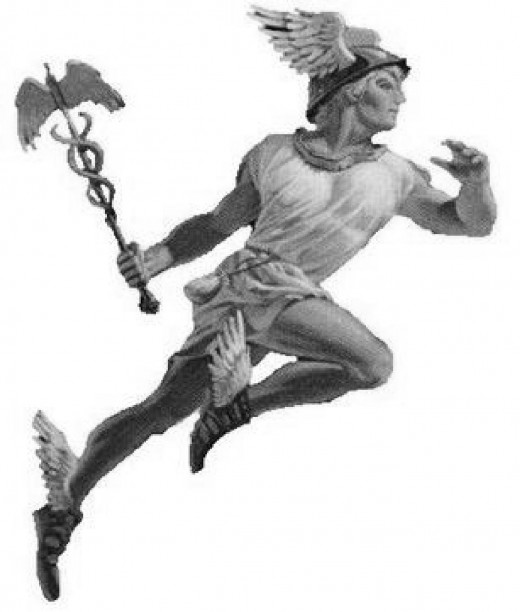
From Dictionary.Com
Fleet: adjective, fleet·er, fleet·est, verb, adjective.
1 swift; rapid: to be fleet of foot; a fleet horse.
2 to move swiftly; fly.
3 Nautical to change position; shift.
4 Archaic to glide along like a stream; to fade; vanish.
5 Obsolete to float; drift; swim.verb
6 to cause (time) to pass lightly or swiftly.
The Rendlesham Light was something that flew, changed-position, faded, vanished, floated, moved-swiftly and, I expect, made-time move quite rapidly too.
In 1980 strange lights were seen by reliable witnesses at RAF Woodbridge, descending into Rendlesham Forest. The servicemen initially thought it was a downed aircraft, but, upon investigation, they saw strange lights moving through the trees, and a bright light from an unidentified object. While undergoing regression hypnosis in 1994, one of the men claimed that the 'craft' he encountered had come from the future, and was occupied by time travellers, not extraterrestrials.
In June 2010, retired Colonel Charles Halt signed an affidavit, in which he again summarized what had happened, then stated he believed the event to be extraterrestrial and it had been covered up by both the US and UK:
I believe the objects that I saw at close quarter were extraterrestrial in origin and that the security services of both the United States and the United Kingdom have attempted—both then and now—to subvert the significance of what occurred at Rendlesham Forest and RAF Bentwaters by the use of well-practiced methods of disinformation.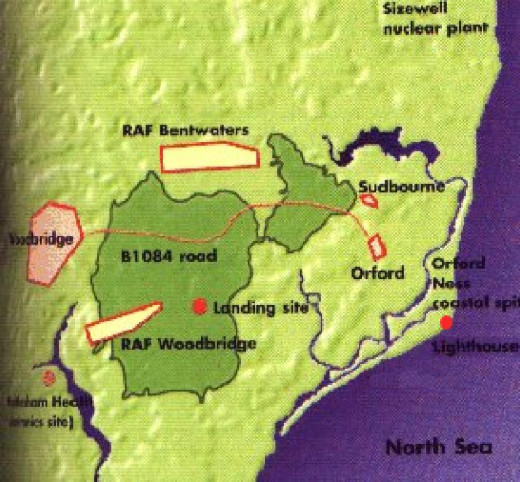
seeing red
Which - in a round-about sort of way - puts-back into my mind that woodland guardian the English called Herne the Hunter, and I wonder if, in former times, they would have said that the weird-lights in the forest was in-fact none-other than that hooded-Herne and the wild-hunt?
Maybe, maybe not. I'm only saying that under the Sun, nothing is new.
It was, as far as I understand it, a red light they repeatedly witnessed in the forest - the colour of anger and rage. I think this is relevant because-of the name of the place, Rendlesham. In the olde tongue, 'rend' meant rage.... And rage is, like silliness, an act of consciousness, it is thinking that leads to anger, after-all.
Also marked on my amazing-map, is Snape, where archaeological investigations have revealed boat-burials and other graves.
I dare-say the experts would come-up-with a chieftain or local big-boots called Mr Snapa to explain this place-name away - but it's such a small and insignificant place it appears that no-one's bothered to invent him. So I won't bother, particularly as I know where the place got its name from - sort-of thing.
I do believe that Snape is where our big-cherub's hair-line is - and it's there because it was cut, or trimmed there, because our big-un has had a hair-cut. I say that because 'snape' is the origin of the word snip, as in trim.
On that point I refer you back to a few paragraphs ago (Sutton Hoo) where we talked-about scissors and their Geminian significance.
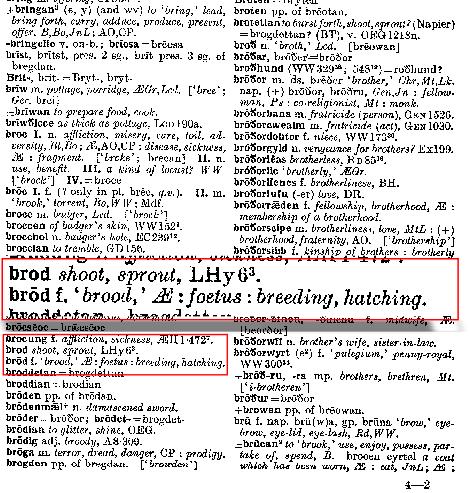
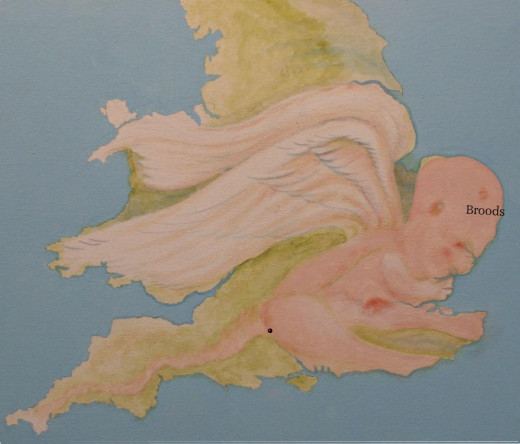
Yarmouth - originally called Gernemwa, got its name, so-they-say, from the river it sits upon, the Yare, which is the opening inland to the Broads, as the ample-waterways around-here are known. In Anglo Saxon, 'Gernenwa; the original spelling, means, yarn, yarn-winder, reel. The place has been a fishing-port since the dawn-of-time, so this makes perfect-sense, in that sense. In another sense, spinning yarns, a Mercurial past-time, has long-been associated with the local fisher-folk, who were famous around these parts for telling tall-tales whilst repairing their nets and lines - the one-that-got-away and all-that. Trouble was - if you weren't from around-here you'd have little real-hope of understanding a word of it - so unique the dialect. The slang word yarco means a chav from Great Yarmouth. The term is so-well established that it has entered dictionaries. They speak a lingo of their own and no-bugger but the yarco's grasps-it.
Any-road, I want to speak-about the Broads - presumably, everyone-thinks the rivers up-here are called-the Broads because the waters are wide and slow-moving - maybe that is the case but I'm convinced it's all-to-do with thinking. In the old-days, 'broad' was spelled brod, and it didn't mean what we assume it to mean. It's one-of-those very clever place-names, this Broads. What it says is along the lines of I think....(complete the sentence),,,, therefore I am.
Let me explain.... 'brod' is brood, NOT broad. This has more than one meaning, of course. 'Brood' is the act of hatching something. In the head where the Broads are, that something would be an idea or plan. 'Brooding' is another way of saying thinking - to brood an idea is to grow and nurture it, in the mind.
'Brood' is also another word for breed, as in nationality or family-group - one's blood-line. The Broads are saying: I am the breed.
In the town is the borough or parish of Runham.... is someone going for a jog, running? Nah. 'Run' is nothing to do with trotting - even though running Is a reference to local-travel. No - a rune is a word or saying, even a proverb. And as I mentioned, the original spelling of the town Yarmouth speaks of spinning and lines and reeling.....
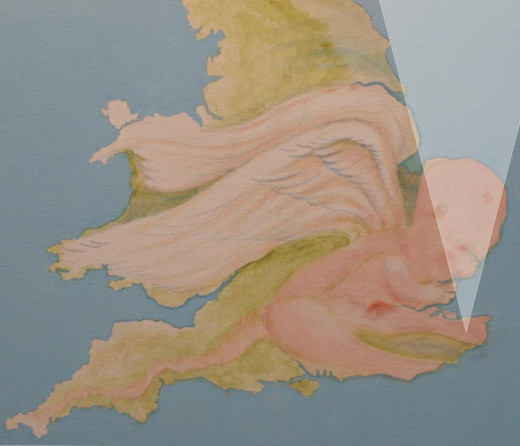
We could stay-here inside this angel's head looking-around to see all the amazing things in here - and believe me, we've hardly scratched the surface - but we've really gotta do-the-Hermes and get some wings-on. It's that time again to step-back and look at the bigger-picture.
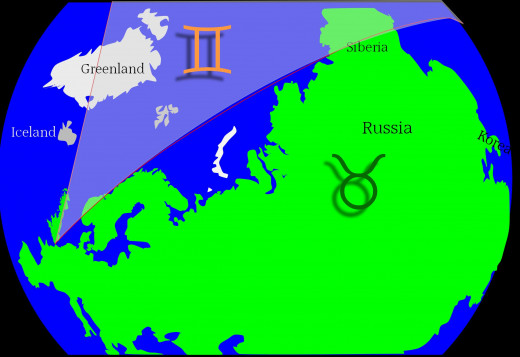
It's pretty-big too - don't ever let anyone tell ya it's a small-world, 'cos it ain't. It's all here. We live in a fractal-universe and everything is everywhere at the same time.
So, the first things our cone-of-Gemini falls-on after expanding-outwards from our angel's ankle are two pretty-cold places, Greenland and Siberia. This Gemini alignment and cone-of-influence includes both the north-geophysical-pole and the north-magnetic-pole.
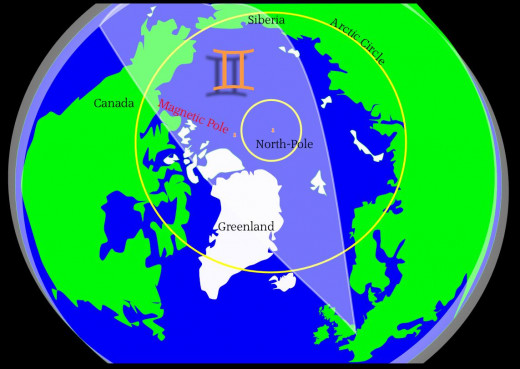
Greenland
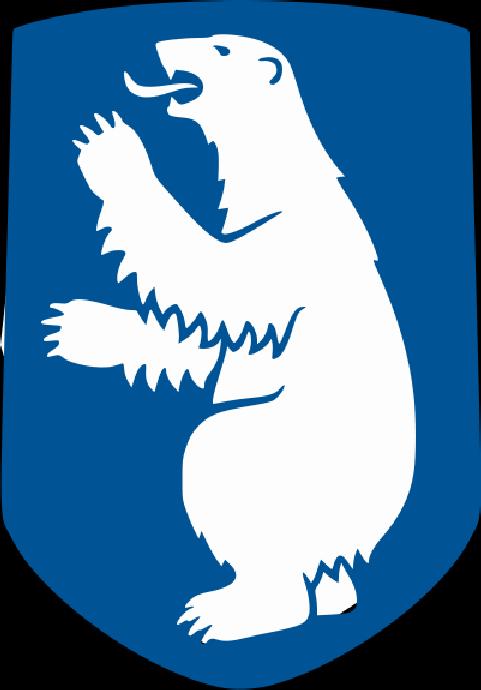
But before we get that-far north, our alignment and cone-of-Gemini 'illuminate' a big-old lump of ice. Greenland (part of North-America) is divided-in-two by our alignment - but's wholly within the Arctic-Circle, and is for that reason the least densely populated country in the world - it's covered in an ice-sheet, so that's a no-brainer. Greenland is dependent on fishing and exporting fish - virtually everyone lives on the west-coast 'cos it's far-too harsh inland and the other coasts are shattered and sharded with fjords. The shrimp fishing industry is the country's largest earner.
The weight of that ice sheet has pushed-down the central area of the land, forming a basin more than 984 ft below sea-level. The land rises suddenly and steeply near the coast. A survey in 1951 showed that, under the ice sheet, Greenland is actually three large islands.
Scientists who probed 1.2 miles through a Greenland glacier recovered the oldest plant DNA on record, a record that said that Greenland was far warmer hundreds of thousands of years ago. The DNA of trees, plants and insects including butterflies and spiders found underneath the southern Greenland glacier was estimated to date to 450,000 to 900,000 years ago, according to the remnants retrieved from this long-vanished forest. These DNA samples suggest that the temperature probably reached 10 °C 50 °F in summer and −17 °C in winter.
Greenland is the closest land-mass to the North Pole.
breaking-the-ice

In these century's of global-travel, remotely-controlled deep-space research, the internet, etc, etc., the ideas we used-to-have regarding 'local' and 'distant,' aren't quite what they used-to-be. These-days, the entire globe of the earth is our local-environment - we better understand the connections between the seemingly individual systems in the ecosphere and we know better that what happens 'over-there' affects what happens 'over-here.' Global-is-now-local.
Gemini governs travel in the local-neighbourhood, and this means something different to us than it did to our forbears. Today, culturally-speaking, the North Pole IS our local-neighbourhood and though you & me may not have been-there, travel-and-the-local-neighbourhood are at the very-heart of the North Pole 'problem.' If you can't get-there in a vehicle, you ain't getting-there at-all - scientific-curiosity will remain unsatisfied. But Gemini's influence is subtle, strategic and problem-solving. The issue of getting-there was bound-to-be solved.
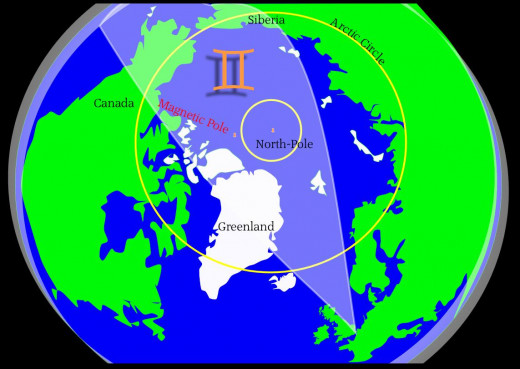
The North Pole is in the middle of the Arctic Ocean - there's no solid-ground here at-all - just a very-deep ocean and a lot-of-ice.
It's so cold up-there on 'the roof of the world,' as it's known, that until the 20th Century (March-May 1948) no-one had sussed-out how to get there - and on the human-scale of things - it's a little-bit remote. The first men to set foot at the Pole were geophysicists, oceanographers and other scientists, plus the flight crew. They were from the former Soviet Union.
Since then there have been an increasing number of expeditions there in various forms of transport - ice-breakers, airplanes, parachutes, submarines, dog-sleds, pedestrians and-all.
In 2007, the Russians also made the world's-first manned descent - 2.7 miles - to the sea-bed at the Pole - in two spheres. They stuck their pole into the seabed at the exact position of the Pole.
In recent years, journeys to the North Pole by light-aircraft, helicopter or icebreaker have become almost routine - small groups of adventurous tourists on extreme-holidays. Parachute jumps have frequently been made in recent years.

When we keep-going in the-same but opposite direction in this sign of polarity, the sign leading-up-to of the Summer-Solstice, where the Sun reverses direction, the alignment doesn't touch dry-land again until it reaches the South Pole - where it turns into the opposite-sign, Sagittarius.
Blimey.... talk-about appropriate...
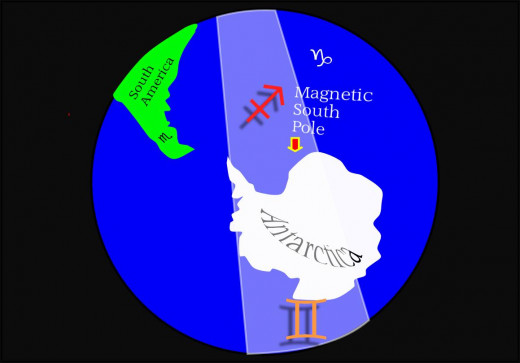
In the sign of the mind, writers, imagination, thinking, education, local-neighbourhood, twins, communication - the sign of people - we've gone to the least populated regions on the planet, people-less even. In the sign of duality, yin and yang, polarity - the sign leading-up-to Summer-Solstice - we've journeyed from one-extreme pole of the globe, to the other
When we in England are experiencing the longest-day of the year, there is 6-Months of 24 hours of light at the North Pole, the land of the midnight-Sun - whilst down here at the South Pole - also called the land of the midnight-Sun, at the very-same moment there is 6-Months of 24 hours pitch-dark.
And with a flash he was off......

